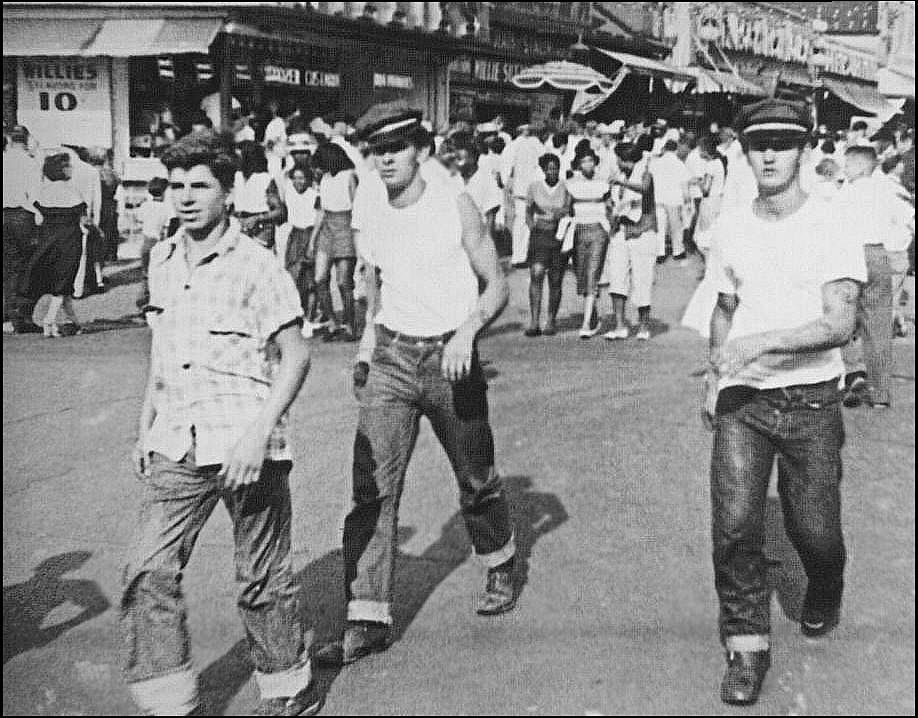
When My World Was Young 1945-56 The Yellow Brick Road 1956-60
What a Wonderful Town 1960-61
Wonderful Town (pt. II) 1962-66 The Gay Sixties 1966-70
The Juicy Life 1971-76
Juicy Life (pt. II) 1976-80
Losing Alexandria 1981-87
The AIDS Spectacle
Losing Alexandria (pt. II) 1987-1990's

WHAT A
WONDERFUL
TOWN!...?
1960 - 1961
...is there really something left after the daily drubbing of the job, where whatever it is we've all produced stacks up here against the sky, looming over us in the traffic and exhaust to leave us, at best, an edgy, dangerous glamour, a hatbrim slant romance. See? You're feeling that New York way again....
Okay, let’s sing us one of the old songs: It’s a hard, tough town, too heavy to pick up and run with and way too big to move with whatever muscle life has left you with this week. Should you take up smoking Luckies? What time is it? What decade have you landed in tonight? What’s your most essential name and what’s your function here? Is it Walk or Don’t Walk, Uptown or Down, the real world or just one more astral fantasy? Some nights are so confusing it gets too hard to tell.
Rafi Zabor
(author of The Bear Comes Home)
Sailors in Times Square, early 60s (photo: Edward Melcarth)
I had $50.00 in my pocket and a new suit when I
stepped off the Greyhound bus in New York. Both parting gifts from my
parents. There's an irony in this if you're familiar with Forties gangster
films: When prisoners finished their sentences and were released from the pen
they got fifty bucks and a new suit of clothes from the State. I felt that
was an entirely appropriate coincidence.
New York wasn't popularly the Big Apple in June1960, though it had been called "the Apple" as early as 1907. Sometimes it was Gotham, but that was sounding as dated as Damon Runyon. Sometimes it was the Big Town, but usually it was just "the city," but like The City, and even native New Yorkers meant Manhattan when they said it. But New York hadn't quite become the picture that sticks in my mind now, when I arrived it was still an old black and white movie in many ways.
A 1963 Miss Subways
 The
Yankees were playing ball in their stadium in the Bronx, even if the Dodgers and
the Giants had skipped town. Ever since 1941 you could "Meet Miss Subways"
each month as a new young female subway rider was
selected to have her photo and a bio on a poster in the trains, publicity shots
at the turnstiles - maybe hiking her skirt to show her "gams" - and thirty days
of fame and glory as the First Lady of the republic of the IRT/BMT and
The
Yankees were playing ball in their stadium in the Bronx, even if the Dodgers and
the Giants had skipped town. Ever since 1941 you could "Meet Miss Subways"
each month as a new young female subway rider was
selected to have her photo and a bio on a poster in the trains, publicity shots
at the turnstiles - maybe hiking her skirt to show her "gams" - and thirty days
of fame and glory as the First Lady of the republic of the IRT/BMT and
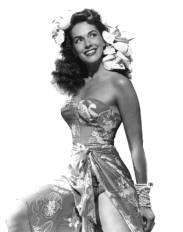 IND..."Change at Times Square/42nd Street for the Shuttle."
IND..."Change at Times Square/42nd Street for the Shuttle."
"My beer is Rheingold - the dry beer" was the New York beer drinkers anthem, and it was cheaper than the national brands (...except that a six-pack of Kreuger's on sale always undercut it.) And each year, beginning in 1939, a beautiful and busty new Miss Rheingold was selected - probably more New Yorkers recognized her than knew the current Miss America.
(right) Jinx Falkenburg, the first Miss Rheingold
Both Miss Subways and Miss Rheingold disappeared from city life in the 70's.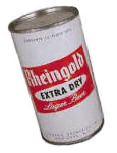
My beer is Rheingold, the dry beer
Think of Rheingold whenever you buy beer
It’s refreshing, not sweet
It’s the extra dry treat
Won’t you try extra dry Rheingold beer?

But Lever House, the glass-walled skyscraper that housed the Lever Brothers Corporation had gone up on Park Avenue in the early Fifties and knocked the socks off of just about everyone.
Lever House, the grandmother of all glass box skyscrapers.
All of the "els," the elevated subway lines, south of Harlem had been torn down. Third Avenue was open to the sky at last: goodbye to the atmosphere of Lost Weekend; hello, high rent Silk Stocking District. By '60 the let's-knock-it-all-to-the-ground-and-start-over juggernaut was getting up a good head of steam. The new Seagram Building was the glory of Park Avenue, and it's restaurants - the Brasserie and the Four Seasons - became in places to go. The Guggenheim Museum, looking like a snail shell disguised as a funnel, had opened and caused as much of a buzz as its collection. For those not of Four Seasons' caliber Top of the Sixes at the new 666 Fifth Avenue was the place to dine while looking down on Central Park. And the West Village was being studded with expensive high rise apartment buildings that were killing the old bohemian neighborhood.
However, block after block of midtown avenues on both the
East and West sides were still lined with late 19th and very early 20th century
buildings; much of the housing in Manhattan was the old brownstones and
tenements. West of Hudson Street in the Village was nowhere, and no one went
into Central Park after dark except for a risky blow job. The Beaux Arts beauty
of Grand Central Terminal straddled Park Avenue at 42nd Street uncontested
splendor, and
what will always be "the old Penn Station,"
a huge classical building derived from the Baths of Caracalla, stood just south
of West 34th Street. And the "best people" still stayed at the Plaza Hotel
or the Pierre at the southeast corner of Central Park. The
Metropolitan Opera House was on West 39th Street, (Lincoln Center was a
neighborhood of slum tenements made famous as the location shots for West
Side Story); Madison Square Garden was on 8th Ave. and 50th Street.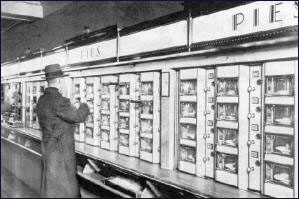
Dining at the Automat
The nearest thing to "fast food" was the soon to vanish string of Automats, or Bickford's cafeterias. The Prexies chain offered the "Hamburger with a college education." Delicious! Lower on the price scale the White Castles cooked up fast - and square-shaped - burgers. Also delicious! The Nedicks chain was for franks (hot dogs.) Orange Julius stands featured a concoction of orange juice and milk that gave the places their name, or for fifteen cents you could have a tropical drink at Grey's Papaya or one of its rivals. Ladies patronized the decorous Schraffts establishments, which seemed to hire their staffs "right off the boat from Ireland" as people often observed. "Meet me at Original Joe's"...meant a straight inexpensive Italian joint on Third Ave. in midtown which was a gay favorite. It became "Original Joe's" when another restaurant opened only a few doors away, using the name Joe's in attempt to get a free ride on their reputation. Pam-Pam, a little burger restaurant on Sheridan Square was a gay institution, though the Riker's burger joint across the street was packed with gay guys in the early morning hours.
At night the Great White Way was bright, but certainly not white. New York street lights gave off a yellowish light which lit a fairly small area. On major arteries store windows, bars and restaurants and advertising signs, as well as the headlights of motor traffic, increased this to a kind of splotchy brightness. Otherwise the streets could be heavily shadowed, and dark enough in many places to make walking hazardous - or dangerous. Long stretches of the streets looked worn and tired, and gusts of wind blew gritty dust through them so bad that many New Yorkers wore sunglasses as a defense not an affectation. The crumbling West Side Highway, elevated several stories above ground on decaying girders and dropping pieces of itself along the way, was a broad path of gloom and noise that wound down the entire length of the island along the Hudson shore.

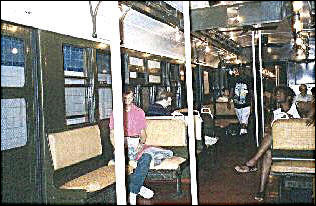 Big comfortable Checker cabs plied the streets, and
were the preferred taxi. But buses were old and falling apart inside and out,
and the bus stops were farther apart then.
Big comfortable Checker cabs plied the streets, and
were the preferred taxi. But buses were old and falling apart inside and out,
and the bus stops were farther apart then.
(left) Early
60s bus;
(right) Interior of IND line
subway car, early 60s
Subway stations were grimy, stunk of piss and were furnished with wooden benches. If the buses were old the trains were ancient. (But for 15 cents....who's complaining?) The subway cars were an appropriate olive drab or battleship grey, the seats were often covered in woven cane varnished to a fare-thee-well or in plastic "leatherette," in either case usually worn, torn or slashed, and small fans circulated the air spasmodically, at least those that worked did. The doors between cars were often left open for ventilation, sending pages from discarded newspapers flying through the air while bottles rolled back and forth on the floor. Derelict drunks sacked out on the trains for the night.
 Gypsy and
Westside Story were the established Broadway musical hits. Bye Bye,
Birdie had just opened. Jason Robards was in The Ice Man Cometh.
(JFK would be elected president in November, and the musical Camelot
would open in the fall and become the nickname for the era.) Old glamour
spots like El Morocco and the Blue Angel were there for the upper crust.
The less affluent could still go to the Roseland ballroom, and much farther down
on the scale was the Tango Palace on Broadway, where men could buy tickets
to dance with a staff of "taxi dancers." (Yes, the world of Ten Cents a Dance
and Private Dancer was still doing business. And here's a ticket
from '61 or '62.)
Gypsy and
Westside Story were the established Broadway musical hits. Bye Bye,
Birdie had just opened. Jason Robards was in The Ice Man Cometh.
(JFK would be elected president in November, and the musical Camelot
would open in the fall and become the nickname for the era.) Old glamour
spots like El Morocco and the Blue Angel were there for the upper crust.
The less affluent could still go to the Roseland ballroom, and much farther down
on the scale was the Tango Palace on Broadway, where men could buy tickets
to dance with a staff of "taxi dancers." (Yes, the world of Ten Cents a Dance
and Private Dancer was still doing business. And here's a ticket
from '61 or '62.)

Amato Opera, 107 seats Sammy's Bowery Follies
(photo: Weegee)
Sammy's Bowery Follies
(photo: Weegee)
Sammy's Bowery Follies with its cast of Skid Row performers was still in business too. And the plebes could see scaled down grand opera sung by unknowns in the tiny Amato Opera in the same tenderloin neighborhood. "The Crossroads of America": Times Square and West 42nd Street ("the Deuce")? It was a combination carnival and trash barrel, but heading straight for hell.
Regardless of what I knew from newspapers, magazines and television, those night-long rides on the Greyhound bus in the spring of my Junior year had been taking me to a New York made up of images my imagination had clipped from those great musicals On the Town and Wonderful Town. I was going to a rambunctious, music-filled, vividly colored Hollywood spectacle - and with the initial sightseeing and gawking during the day, and the rushing from bar to bar in taxis at night it had seemed very much like that. But what I'd learned while living in the city with Bob Manahan the summer of '59 toned the picture down a bit. However, after I returned to college in September for my senior year, sometimes - especially while listening to a couple of current Broadway show albums - I did slide back sometimes into those old technicolor fantasies.
However, later that fall word of the anti-gay campaign in New York dimmed them rapidly. Each new report of the relentless sweep of this crusade made it harder to believe I had once imagined New York as a distant outpost of European urbanity and tolerance toward homosexuals - a fiction in its own right, of course. And I had to accept that my narrow escape in the Mais Oui raid was the nasty real deal, and not a giddy caper.
.jpg) After
graduation I had returned to my hometown. My parents had it planned out
that I would find a job in nearby Rochester and live with them, and their agenda
was clearly to maintain total vigilance and control over my life. There
was no way I could acquiesce, and the tremors of a coming eruption got stronger
each day. One morning, after an argument with my mother, she abruptly said
that the only way I could avoid a fist fight with my father would be to leave.
But I was broke: and so I received a new suit and a fifty dollar subsidy.
These were bestowed with ardent ill wishes for my failure in New York, and a
thundering pronouncement that when I called up in a week or two begging for
help, I would be fetched then to return "home" and from then on I would do exactly
what I was told - if I knew what was good for me.
After
graduation I had returned to my hometown. My parents had it planned out
that I would find a job in nearby Rochester and live with them, and their agenda
was clearly to maintain total vigilance and control over my life. There
was no way I could acquiesce, and the tremors of a coming eruption got stronger
each day. One morning, after an argument with my mother, she abruptly said
that the only way I could avoid a fist fight with my father would be to leave.
But I was broke: and so I received a new suit and a fifty dollar subsidy.
These were bestowed with ardent ill wishes for my failure in New York, and a
thundering pronouncement that when I called up in a week or two begging for
help, I would be fetched then to return "home" and from then on I would do exactly
what I was told - if I knew what was good for me.
I had never before taken the trip to New York in such a sober mood. I knew beyond a doubt that the knowledge of my being gay had cut me off irrevocably from my past roots - not least my family; and this trip was a flight from retribution, even if it was no longer the journey to a gay utopia.
Pavement level reality when I stepped off the bus in June 1960 had nothing in common with verve and joy of On the Town. One of the most popular shows on television in these years was the Naked City series (1958 - 63) set in New York. It was based on Jules Dassin's 1948 award-winning movie of the same name, and the film's noir style had been inspired by New York photographer Weegee, who had published a book of photos of New York life called Naked City in 1945. That atmosphere was successfully carried over into the TV series. And though the city was changing, on the whole the gay life I would experience my first few years in New York had that same black and white underworld atmosphere: it was a brittle and threatening world, where glancing over your shoulder became a reflex.
On March 14, 1960, the New York Times ran an article, “Life on W. 42nd St. a study in decay.” I missed it; however, the Times itself would soon provide me with a paid education on the topic, and ultimately leading to a brief role as part of that decay.
THE PURGE
This era, had begun with the Lee Mortimer crusade in the Mirror in late 1959, and ran on with little respite to the end of the administration of Mayor Wagner, whose last term in office ended in 1965. It was a bleak and paranoid period of gay life in the city. (My own view of these years, though, is that they were also the prolonged death throes of the 50's.) Several influences contributed to the official anti-gay campaign, most of them having to do more with the vagaries of local politics, in my estimation, than with any general moral outcry.
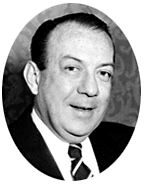 (right) Mayor Robert Wagner
(right) Mayor Robert Wagner
Perhaps this is demonstrated to some degree by remembering that these same repressive years also encompassed the period of the great civil rights campaigns of the 60s, the presidency of John F. Kennedy (1960 - 63), whose style and programs brought an excitement and glamour into national life after the staid Eisenhower era (1952 - 1960), and the emergence of the Hippies.
New York like a number of other cities in the United
States had been controlled by a party machine, many of these had
their origins in the post Civil-War era. The northeast of the U.S. had become a
stronghold of the new Republican party under Lincoln. The only way the
Democratic party was able to lose its party-of-the-Rebellion stigma and regain
political influence was to woo the successive waves of European immigrants who
were arriving here. Over the decades these machines evolved as powerful forces
in the life of many major cities, becoming sources of patronage, a place for
grievance and redress and avenues to power for the new arrivals. In NYC the
Democratic party machine was known as Tammany Hall. 
Though its influence had waned in the late Thirties and the Forties, it had been revived under the leadership of Carmine DeSapio in the Fifties, a departure from its history of Irish bosses. Tammany was again a potent power able to control and deliver many thousands of votes, but it was marked by dubious dealings and connections as well. Opposed to Tammany Hall were the emerging Reform Democrats who espoused more liberal social policies and party politics free from the manipulation and corruption of the Tammany machine. Any Democrat who wanted to be mayor in New York City in this era had to keep and eye on both of these camps if he wanted to ensure his election. There were shadowy connections involving Tammy Hall; racketeers from the various crime syndicates ("families") -- Italian; the waterfront racketeers - often Irish; and the police force - heavily Irish and Italian in makeup. Mayor Wagner had eased himself away from Boss DeSapio, and escaped being dragged down with DeSapio and Tammany Hall in the Sixties. What this meant in practical terms was that Wagner had adroitly balanced reform and the appearance of clean government, which appeased Jewish and WASP Reformers, with a day-to-day system of government that did not alienate the Tammany Hall faithful, largely working class and Catholic.
One easy scapegoat in any red herring "cleanup" campaign was the gay population. (The other was prostitutes.) Raids on gay bars and meat racks could be purveyed to the press and voting public as part of a campaign against crime and vice with no fear of alienating anyone. It also spotlighted the police as guardians of the moral order, and helped deflect the frequent charges of corruption and bribery which were leveled at them. It was a diversionary tactic that helped the Wagner administration (and certainly the police force) present itself as the enemy of crime and corruption in a very handy manner without in fact doing anything very substantive about either.
Most gay bars and restaurants were operated by the
Mafia, or under their "protection." (Rumor was that the profits from this
activity helped finance the emerging heroin trade.) Bribes were paid to
the police, which meant most of the harassment was directed onto the patrons and not
the establishments themselves - until such time as circumstances dictated that
a bar had to be closed. Wagner's cleanup campaign disturbed this
lucrative arrangement. However, it was better to have this action in the
hands of the police than in those of some special commission, which might do
permanent or long-term damage to the status quo and expose scandalous ties
between government and crime into the bargain. A current
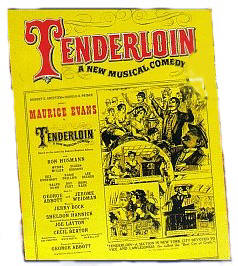 Broadway
musical,
Tenderloin, was based on one such period of sweeping moral reform - and its
predictable failure, and another musical, Fiorello, dealt with political corruption in
pre-WW II New York. And now, once again, the same old, same old - the more things change...etc.
However, Wagner also became increasingly focused on making New York squeaky
clean for the approaching 1964 World's Fair.
Broadway
musical,
Tenderloin, was based on one such period of sweeping moral reform - and its
predictable failure, and another musical, Fiorello, dealt with political corruption in
pre-WW II New York. And now, once again, the same old, same old - the more things change...etc.
However, Wagner also became increasingly focused on making New York squeaky
clean for the approaching 1964 World's Fair.
Thus, for the Mafia and the police it was a matter of playing a waiting game until the politicians - and the press and public - lost interest. In the meantime, gay social life was ground to pieces by these forces - none of which would have seen this in anything less than a positive light whatsoever. While the atmosphere of illegality and the threat of punishment hung over gay life in the normal course of things, at this juncture the threat of force was actualized in an ongoing repression of gay life that to some degree affected almost everyone gay. It was not a matter of a couple of "tea room queens" being entrapped by a plainclothesman, or a few bar patrons being hassled in a raid, this time the clear intent was to close down public gay life across the board. Gay life for the next few years was to be an oftentimes dreary game of hide and seek. There would be moments when Syracuse would almost seem like a paradise lost in comparison.
BACK TO THE KID WITH A SUITCASE
My first stop was the West Side Y (West 63rd &
Central Park West), which was notorious as a place to cruise, and was virtually
a gay hotel - though the management quietly did everything they could to put the
clamps on both. I'd been warned by Bob to be very careful about what I did
there. Consequently, I was very aloof, and my impression in any case was that
gay guys were being extremely cautious about any "action." The main draw for
me though was that it was cheap and clean, and in a nice neighborhood on the
edge of Midtown. After a week I moved to the Sloan House (YMCA) on West 34th
Street and 9th Ave, which was slightly cheaper, though in a somewhat sleazy
neighborhood. It had the same reputation as having been a wild place for
pickups until very recently.
On my first day there I was taking a shower alone when someone came in and used the sinks around the corner. Before he left he peeked into the showers. A minute later a dark-haired guy with a gym-built body (these were not a dime a dozen in 1960) came in to take a shower. He was extremely chatty and in less than a minute invited me to his room - though with the proviso that I go get dressed first and then come to his room. (This I learned later was so you didn't get caught in someone's room without your street clothes.) When I got there I found that the first guy, who had checked out the shower, was there too. They were lovers, and the hunk was often used as bait to get a threesome - although in this case it didn't work as I said I "haven't done that yet" (though I have no doubt I would have if the first guy had appealed to me.) Nevertheless, the three of us went out that night to the Cherry Lane bar on Commerce Street (in the Village), and then to what was clearly a new venture as a gay bar, the Coral Lounge, just down the street from the Sloan House Y. These guys had been staying at the Sloan House for a couple of weeks, and warned me that employees patrolled the hallways wearing sneakers and listened at the doors if they thought guys were having sex.
I lucked out with a job. And I had to. As a college graduate I would be called up for a physical soon and be reclassified 1-A, prime draft bait; therefore, my chances of finding a job - especially as I needed one immediately - bordered on zero. Through a straight woman friend of Rob's that I'd met the past summer I managed to get a temp job at the New York Times News Service as a clerk/gofer for the summer.
Within a week or so, in a desperate effort to eke out a miniscule salary, I moved to Jamaica, a remote neighborhood in the outer borough of Queens. I got a room in the Jamaica Y on Parsons Blvd., at what for me was significantly less money than I'd been paying in Manhattan. Out there the gay life situation was even worse. There was one very small, dingy gay bar, the Bull's Head, which operated in an atmosphere of palpable tension on the part of both customers and management. Queens, even before the crackdown, had not been even remotely as open as Manhattan. Moreover, this bar wasn't in the Jackson Heights or Forest Hills neighborhoods, which at least had small gay populations -- it couldn't have hoped to be more than a quick-profit venture before getting padlocked.
My salary was very small, even for this era.
I could go to a bar and nurse a couple of beers for the evening, but after
paying for rent, meals, transportation and miscellaneous living expenses it
wasn't often that I got to do more expensive things. I do remember, though,
that one of the first things I did was buy a two-fer (half-price ticket) for a matinee performance of
Gypsy. I went by myself, so I got totally taken up in the performance
like probably never happened again. Later on this year I did get to
see Leave It To Jane at the Sheridan Square Theater, Off Broadway tickets
were considerably cheaper than Bway back then. It was a revival of
a Jerome Kern 1917 musical with a very thin story and silly dialogue and humor,
and it was too big a stretch for my limited experience to appreciate - except for
Dorothy Greener's performance, especially her number "Cleopatterer."
(Dorothy was an excellent comic actress, and she used to come to the Five Oaks
often when I went there much later in the Sixties.)
When I'd arrived at the beginning of summer I found only two bars left open out of the more than two dozen from the previous year, the Cafe De Lys and the Cherry Lane, which were about a block from each other in a then very quiet part of the Village just east of Hudson Street. (Actually, west of Sixth Ave. the Village was a fairly subdued place overall, despite having many restaurants and bars.)
(right) Peter, the de Lys bartender
The de Lys, was the smaller place and its crowd was more relaxed. Its juke box had such an extraordinary menu of selections that it must have reflected someone's personal taste - choice jazz ballads and only the better pop music. I especially remember Etta Jones' (right, Etta Jones not Etta James) recording, Don't Go To Strangers. The de Lys also had an affable bartender, Peter, who had a beautiful gym-built bod, not by any means a common thing in these years.
 The Cherry Lane bar was
a bigger, livelier place, and a few blacks and Hispanics were part of the regular crowd. It also allowed dancing from time to
time that summer, which was courting disaster, but perhaps it was a way of
trying to increase the profits while there was still time. The atmosphere
was not like a dinner dance with the upper level of the upper crust, by any
means.
The Cherry Lane bar was
a bigger, livelier place, and a few blacks and Hispanics were part of the regular crowd. It also allowed dancing from time to
time that summer, which was courting disaster, but perhaps it was a way of
trying to increase the profits while there was still time. The atmosphere
was not like a dinner dance with the upper level of the upper crust, by any
means.
Cherry Lane
Theatre (canopy), the doorway after the bench was the bar entrance,
building with the red awning was the Blue
Mill restaurant, popular with gay men.
One clique of regular patrons from the Village was inclined to exercise a kind of "ownership" of the place by being aggressively loud and campy. They are not to be imagined as posturing hot-house flowers, however, several were very husky guys. One of the latter was Hal, a big young man with a voluptuously handsome face, who delighted in throwing out bitchy put-downs and provoking confrontations even with total strangers. I remember one night when he baited a new customer, and after the second or third remark the guy wasn't having any, thank you. The guy's friends tried to restrain him, but Hal was in his glory and poured on the taunts. The guy broke loose, hit Hal with a volley of punches and decked him in a matter of seconds. All hell broke loose - shouts, curses, fists flying - and for a few moments this "fairy bar" looked a waterfront dive.
And then there was the Julius Bar - Julius's - on West 10th between Seventh Ave. and Greenwich Ave. in the Village, but it resisted with all it's might to keep from becoming an openly gay bar. Though it was a battle barely won, the management was unrelenting in its efforts no matter how many gay guys might patronize the place. I never felt really comfortable there as a result, but then that was their wish.
A FULL-TIME JOB AND "THE BOYS" FIND AN APARTMENT
At the end of the summer I was able to get transferred into the Times newsroom as a full-time copy boy. I worked at night, which was the peak time for the Times as it is a morning paper. At 3 a.m. subway service was as bad as it got: interminable waiting for the E train to Jamaica, and then the long ride out hitting all the local stops could add an hour and a half to the day. It also made having a social life in Manhattan a major problem. A trick I met in a bar invited me to stay at his place in Manhattan, a sparsely furnished apartment above Johnnie Johnson's nightclub on Second Avenue, and then after a month or so I got an apartment on West 81st and Amsterdam Avenue, on the Upper West Side, with Milton, a longtime friend of his who'd just arrived in town to try to make a life for himself as a pianist in show business.
Milton and I were shown the apartment by a Hispanic super, who took care of a bunch of buildings on a part-time basis - the radiators were stone cold on a bitterly cold November day (a harbinger of more of the same all winter it turned out.) We then were sent to an address on West End Avenue to see Mr. Goldman, the very appropriately named landlord. It was a large, old apartment where a Scrooge-like man sitting behind a huge desk in an otherwise unfurnished room, interviewed us as we stood before him. In closing he smiled and commented that he didn't mind renting to "boys like you," and he was sure we would make good tenants. I was to learn from a landlady later on that his attitude was a not uncommon sentiment amongst many Westside landlords: Better fags than Puerto Ricans and blacks. They didn't mind if you were "that way" if you were white, though gay Hispanics and blacks did seem to have a bit of leg up over their straight compatriots.
"BOYS"
The use of "boys" to characterize gay males was often used with the same condescending intent as when it was applied to black adult males.
Contrary to the 90's and after, when there would be an accepted Boy image that many men (straight and gay) would aggressively seek to emulate, and when adolescence would virtually stretch into the mid-twenties, no gay males in the Sixties strove to affect a Boy look or habits. You would have been taken for a total jackass. For one thing, the youth market and culture were in a nascent stage of development, and there was little, if any, ambivalence about the desirability of leaving the hallmarks of adolescence behind. "Maturity" was the constant injunction during high school years, and maturity was accepted and yearned for by kids as the Promised Land of privilege and independence. In the Fifties and early Sixties college students very self-consciously repudiated the music and dress of teenagers and created their own stereotype, which said young adult. The goal of young people in this era was to achieve adulthood, which meant freedom, increased status, access to money and power. Being designated a "boy" as an adult meant that in some ways you hadn't made it completely - most frequently, probably, in reference to being unmarried. (The expression "the boy's night out" pointed, even if veiled as humor, to married men acting retrogressively.)
Homosexuals were not only not real men, as "boys" they were not really adults either. And, of course, from there it was only a short step to "girls."
When the anti-gay columnist, Lee Mortimer, warned Allen's bar and restaurant and other ostensibly straight establishments about having gay customers, there was nothing neutral or unclear in his use of "the boys" in referring to gay men. Even when used by gay men, "gay boys," as far as I can recall was usually a put down. Many years later, in the mid-Seventies, I had a landlady who habitually referred to her gay male tenants and their friends as "you boys," a term I never heard her use with straight males tenants, even the single ones.
WEST SIDE
STORY
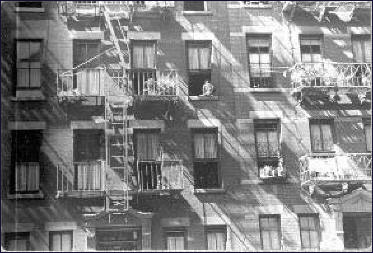
"...Moreover, this entire region [the Upper West Side] combines in its general
aspect all that is magnificent in the leading capitals of Europe...in our grand
Boulevard [Broadway] the rival of the finest avenues of the gay capital of
France, in our Riverside Avenue the equivalent of the Chiara of Naples and the
Corso of Rome, while the Beautiful 'Unter den Linden' of Berlin and the finest
portions of the West End of London are reproduced again and again."
Egbert L. Viele, 1879
NYC tenements, 20th century
The Upper West Side runs from Columbus Circle at the southwest corner of Central Park north to the vicinity of Columbia University, and is bounded by Central Park on the east and the Hudson River (and Riverside Park) on the west.
Today its gentrification is complete, but in 1960 it was just beginning. Generally speaking, its avenues were lined with large and often architecturally impressive apartment buildings, or shabby old commercial buildings and/or crumbling tenements - which depended on the particular avenue; while the streets were mostly filled with New York's famous brownstone houses, once private homes, but converted to small apartment buildings and rooming houses. (Note: In most of Manhattan the broad "Avenues" run north/south, whereas, the narrower "Streets" run east/west.) Other neighborhoods to the south of Manhattan's Upper West Side had their own names, e.g. Hell's Kitchen (in midtown), Chelsea (West 20's), Greenwich Village (below West 14th), etc.
With the general exception of the bohemian Village and Chelsea, the rest of the West Side - Hell's Kitchen and the Upper West Side - was very definitely not the place to live. On the other hand, a single guy living in the Village would be assumed a faggot. But with the demise of the Third Avenue el on the Upper East Side the gentrifying area from there to the river had become a very desirable neighborhood - and had the desirable telephone exchanges. In 1960 New York City telephone exchanges were still named, and exchanges were specific to neighborhoods. Thus, a Templeton 8 number indicated that you had an Upper East Side residence, so did Butterfield 8 (as in John O'Hara's novel of the same name.) Gay men looking for a safe, respectable address without tell-tale associations headed over there, especially those from white middle class backgrounds. And vest pocket neighborhoods farther south, such as Gramercy Park and Murray Hill were very desirable as well. They were something like "address insurance", and certainly a plus when you wanted to shoe-horn your (closeted) white middle class self into the New York Athletic Club.
The tenements on the west side of Broadway just above Columbus Circle in the lower Sixties (i.e., streets numbered West 60th through West 69th), the area where West Side Story was set, were being razed to make way for Lincoln Center for the Performing Arts. Passing by on the #11 bus, those gutted blocks reminded me of the newsreels I had seen as a child of bombed out London or Hamburg or Berlin. The idea that whole streets could be knocked down and all traces of their former appearance vanish, or in this case even the actual streets themselves disappear from the map, was still new to me.
Central Park West was the eastern boundary of the Upper West Side. It was
lined with opulent old apartment buildings, and for much of its length was still
a desirable and moneyed address. The avenue has buildings on its west side
only, which means they have an unobstructed view across the Central Park. The east
side of the street has just a sidewalk, and many trees and benches, and runs along the stone
boundary wall of Central Park. This side of CPW was also one of the city's
busiest meat racks and cruising areas at night from the mid-Sixties up to the
entrances to the park (and the area of the Rambles) at West 78th and 81st streets. 
The western boundary of the Upper West Side, Riverside Drive, faced a lovely park and overlooked the Hudson River, and though it had seen much better days it was still considered a fairly decent, if deteriorating neighborhood. Parts of Riverside Park were also used as meat racks and pick-up areas at night.
(right) Soldiers and Sailors Monument
The Soldiers and Sailors monument in the upper 80's was notorious, but somewhat dangerous as young muggers sometimes descended on the place and picked off victims. West End Avenue, one block west of Riverside, was lined with large apartment buildings, much plainer looking than the grand ones on CPW, once fashionable but now faded and progressively more tired the further north you went.
 Upper West Side
Houses, a majority the classic Brownstones.
Upper West Side
Houses, a majority the classic Brownstones.
While its east and west perimeters housed middle class and wealthy white people -
many of them Jews - and the offices of doctors and dentists, the broad central
section of the Upper West Side was inhabited by a mixture of far less affluent
folks. Between these outer avenues were Broadway, Amsterdam Ave. and
Columbus Ave. They and the streets which crossed them were an area which
ran a negative gamut from dingy to slum. Some of these were representative of the white ethnic families that had moved
into the neighborhood as it began its decline (Irish, German and East European Jews seemed to
predominate), but it had also attracted a newer population of non-ethnic whites
who earned small or precarious incomes, and last - in many respects - was the
very large minority of Hispanics and a smaller
number of blacks, who as groups were
certainly very poor.
(right) Hotel Lucerne, W. 79th & Amsterdam
And even in its glory days the Upper West Side had attracted actors, and the Lucerne Hotel on the corner of Amsterdam and 79th St. was where the famous actor, James O'Neil and his wife had lived for awhile, and where their son, Eugene O'Neil, later to become one of America's greatest playwrights, was born. The Lucerne was still there when Milton and I moved in two blocks away, but it had become a seedy dump with torn curtains and window shades flapping out the open windows, and tough looking men boozing on its front steps. (It has been refurbished and is once again a fine hotel.)
Verdi Square, 72nd & Broadway
Actors and dancers were part of the newer white population
which had
been attracted to the neighborhood because of its low rents, as well in their
case its closeness to the theatre district just west of Times Square.
However, the
Upper West Side itself had been part of the theatre neighborhood of the 1920's.
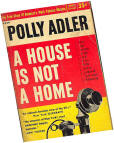 Shuffle Along, a black musical, opened on West 63rd Street and introduced
the hit song, "I'm Just Wild About Harry." Langston Hughes credited the show
with inaugurating the Harlem Renaissance. The Charleston, a dance craze of
that era, was first seen in a musical at the Colonial Theater at 63rd & Broadway
The famous Jazz Age madam Polly Adler moved into the apartment of a showgirl
on Riverside Drive and began running the first of her many classy bordellos.
Crime lords Meyer Lansky, Lucky Luciano and Frank Costello each lived in the
Majestic Apartments at 72nd and Central Park West for a time, and Costello was
gunned down in the lobby in a failed gangland assassination in 1957.
Shuffle Along, a black musical, opened on West 63rd Street and introduced
the hit song, "I'm Just Wild About Harry." Langston Hughes credited the show
with inaugurating the Harlem Renaissance. The Charleston, a dance craze of
that era, was first seen in a musical at the Colonial Theater at 63rd & Broadway
The famous Jazz Age madam Polly Adler moved into the apartment of a showgirl
on Riverside Drive and began running the first of her many classy bordellos.
Crime lords Meyer Lansky, Lucky Luciano and Frank Costello each lived in the
Majestic Apartments at 72nd and Central Park West for a time, and Costello was
gunned down in the lobby in a failed gangland assassination in 1957.
Later, author Ira Levin would set Rosemary's Baby (1967) in the neighborhood, and Roman Polanski would film the movie at the Dakota apartment building on W. 72nd St. & Central Park West.
Possibly the presence of gay theatre people (plus the low rents, of course) was what attracted other gay men to the neighborhood. As I was to learn over time, the Upper West Side seemed to have had a gay population whose history went back to the beginning of the Fifties and perhaps the Forties. The popular Cork Club bar had been located there in the early Fifties as well as the Verdi, both near Verdi Square at 72nd and Broadway; and in the late Fifties two popular dance bars, the 415 on Amsterdam in the lower 80's and the Mais Oui in the 60's near Broadway. The Central Park West cruising scene had been going on for years and was largely made up of local residents of various ethnicities.
Alan Helms, "Young Man from the Provinces" cover. Lou Degni (Mark Forrest) by Lon of NY.
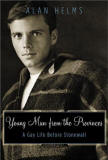
 The 50's/60's self-appointed Golden Boy of New York gay life, Alan Helms, began his
saga in the city on the Upper West Side. In 1957 the physique photographer
Alonzo Hannigan, known as Lon of New York, moved his studio to an
apartment on West End Avenue once occupied by Mae West, and after it was raided
by the police in 1961 he moved over to West 72nd Street.
The 50's/60's self-appointed Golden Boy of New York gay life, Alan Helms, began his
saga in the city on the Upper West Side. In 1957 the physique photographer
Alonzo Hannigan, known as Lon of New York, moved his studio to an
apartment on West End Avenue once occupied by Mae West, and after it was raided
by the police in 1961 he moved over to West 72nd Street.
The fall of '60 was very cold, and the winter was worse, and the streets often virtually empty. I still worked nights and slept days, my days off never included Friday or Saturday nights. I would run over to the 8th Ave. IND (subway) on Central Park West in the late afternoon, or catch a bus on Columbus for downtown if it wasn't too cold to wait in the open. In the early hours of the morning I hustled back from the subway as fast as I could, and the street lighting was so bad that it was pitch black in some places. As far as I knew there were no gay bars on the West Side, so I went to whatever part of town where I heard one had opened.
At one point that winter a powerful blizzard choked the city with drifts that brought traffic to a complete standstill and buried cars and sidewalks for days. The silence was eerie. I walked down the middle of Columbus Avenue to work as even the subways weren't running.
 One
evening on my way to work I was almost alone on the IND platform, only two or
three other people waiting at a distance from me. I saw a train coming
down the tunnel, and the draft from it began to suck up trash and dust. I
heard footsteps on the stairs as someone raced down from the token booth to be
sure they didn't miss it. A man dashed onto the platform forty or fifty
feet from me and looked up the tunnel. The train had almost reached the
station. He jumped down onto the tracks, curled up on his side between the
rails and put his head on a rail, resting it on this folded hands. For
just a few seconds he looked like a child going to sleep. The trainman
slammed on the brakes, but it was useless. It was a short train that came
to a stop farther down the tracks. The man's body was almost in front of
me, his head smashed like a melon fallen off a truck.
One
evening on my way to work I was almost alone on the IND platform, only two or
three other people waiting at a distance from me. I saw a train coming
down the tunnel, and the draft from it began to suck up trash and dust. I
heard footsteps on the stairs as someone raced down from the token booth to be
sure they didn't miss it. A man dashed onto the platform forty or fifty
feet from me and looked up the tunnel. The train had almost reached the
station. He jumped down onto the tracks, curled up on his side between the
rails and put his head on a rail, resting it on this folded hands. For
just a few seconds he looked like a child going to sleep. The trainman
slammed on the brakes, but it was useless. It was a short train that came
to a stop farther down the tracks. The man's body was almost in front of
me, his head smashed like a melon fallen off a truck.
I
was the only witness. I was interviewed by the police at the scene...my
boss was pissed because I was late for work, never mind that I 'd seen some poor
wretch destroy himself; then later I was visited twice by officers from
different branches of the police department - my supervisor was steaming.
One of the late editions of the Times had a brief paragraph about
the
incident buried in the back pages. He had lived in a rooming house not far from
me: middle aged, no job, a name and an address - but no other personal
information was found on his body or in his room. I finished on the last
shift and got home after four a.m., about an hour later the phone wakes me:
it's a guy from the Transit Police! Could he stop by to interview me.
And it wasn't just the same list of questions yet again, but - sorry - I would
have to go down to the subway station and describe what happened at the
scene...so, about five a.m or five-thirty the two of us walked back in the
freezing ass cold to where my night, and nightmare had started. The
horrible scene, the guy's
anonymity have remained with me.
In this place where the sound
of sirens never ceases
and people move like a ghostly traffic from home
to work
and home,
and the poor in their tenements speak to their
gods....
Mark Strand
from Night Piece (after Dickens)
Except for ducking into a bodega (small Hispanic grocery) to buy something for breakfast, or maybe stopping at the all-night greasy spoon on the corner of Amsterdam & 81st to pick up a couple of burgers on the way home - and being aware that the customers were mostly Hispanic and black - I had seen almost nothing of the neighborhood I had moved into.
Then came a warm spring day. There were dozens
of people on the stoops of the tenements next door and across the street, people
hanging out the windows too and radios blasting salsa music (though I had no
idea what it was called.) I turned the corner onto Amsterdam Avenue and
stopped dead in my tracks. Here it was, just like the lyrics in Westside
Story, "Puerto Rico in America!" And the Dominican Republic and Cuba
and Haiti too. It was if someone had given the neighborhood a shot of
adrenalin: hundreds and hundreds of people...music, noise and
talking, yelling and fighting in Spanish and Creole...racks of clothes displayed
in front of stores and piles of merchandise on the sidewalk...
(right) Oshun, a Santeria orixa in her Christian guise
signs in Spanish advertising the services of lawyers, translators, diviners...little Hispanic eateries - comidas chinas y criollas and botanicas, which sold the paraphernalia of Santeria, the Afro-Latin religion. It wasn't entirely a pretty Caribbean travelogue for a callow recent college grad, however.
 Burglary was endemic. Many apartment doors,
like ours, were fitted with "police locks" in addition to one or more regular
locks. These were thick iron bars that fitted into a metal slot in the
floor while the upper end leaned against the door and slid into a metal box in
the middle of the door about a third of the way up from the floor. They
were opened with a key that caused the bar to slip aside, letting you push the
door open. Without a key, kicking the door down and knocking it off its
hinges was the only way to gain entry. Windows often had security gates on them.
There was a darker side too: the incredible squalor, violence and murder of the
Endicott Hotel (now a classy condo), the dealers who melted into the doorways
when the cop cars cruised slowly down the streets, the gangs of brawling young
drunks that hung out on certain corners at night...narcotics and prostitution.
Coming home from work in the early
morning hours became scary now the weather was warm.
Burglary was endemic. Many apartment doors,
like ours, were fitted with "police locks" in addition to one or more regular
locks. These were thick iron bars that fitted into a metal slot in the
floor while the upper end leaned against the door and slid into a metal box in
the middle of the door about a third of the way up from the floor. They
were opened with a key that caused the bar to slip aside, letting you push the
door open. Without a key, kicking the door down and knocking it off its
hinges was the only way to gain entry. Windows often had security gates on them.
There was a darker side too: the incredible squalor, violence and murder of the
Endicott Hotel (now a classy condo), the dealers who melted into the doorways
when the cop cars cruised slowly down the streets, the gangs of brawling young
drunks that hung out on certain corners at night...narcotics and prostitution.
Coming home from work in the early
morning hours became scary now the weather was warm.
I'd never known any Hispanic people and had only a
vague academic knowledge of their cultures from sociology courses I'd taken. But
in the next few years Latino popular culture would become a familiar, if
secondary,
note in my life - and until the mid-Seventies salsa and merengue
were part of the background music of the neighborhood - and in both my personal life and at various jobs I would have
Hispanic friends and acquaintances, as well as sexual partners. However,
at this point I was encountering "Puerto Ricans" for the first time, and
these were the people that many (perhaps, most) whites considered the source of
everything that made the West Side a bad place. (White New Yorkers often lumped all
Hispanics together as "Puerto Ricans" at this time, those with more contempt
called them "Spicks" - from Hispanics I'm assuming.)
"What do they know about love uptown!?"
from Greenwich Village, U.S.A, which played at 1 Sheridan Square in 1960
(At this time the "uptown" being given a verbal sneer would have been the
Upper East Side.)
THE BARS
The De Lys and the Cherry Lane closed late in the year. (Julius's remained open and attracted a persistent gay clientele, however, it was an avowed straight bar whose temperature for gay men ran from unwelcoming to aggressively hostile.) The gay Finale restaurant - which may have actually been called the Grand Finale - managed to remain open throughout the years of harassment, perhaps because it attracted a very small and quiet bar crowd. (Anyway, it was too rich for my blood.) The gay bar scene remained furtive and unstable for years, marked by a series of short-lived places numbering in the dozens, without a doubt, if I could remember them all - Glennon's, 14th Street Cafe, 19th Street Cafe, Coronet, Bleecker St. Tavern, the Hat Box, the Campus, Jack & Nats and on and on. Usually no more than three were operating at the same time, often just two as far as I knew, and their life spans were sometimes counted in weeks - months if they were lucky. It went on like this for several years. Open/close, open/close, now here/now there. Though these places might be pretty crowded on a Friday or a Saturday night, considering that there were so very few open at the same time, most guys couldn't have been patronizing them. Socializing with friends and giving and going to parties played a much larger part in gay life than in later decades.
I was struck by the mix of guys in Glennon’s the first time I walked in. My impression up until then had been that bars in the city could easily be categorized by the type of customer they appealed to, and that certainly had been the way they had been described and regarded by Bob Manahan and the other people I'd first met in '59. However, in Glennon's there was no discernable physical type, no predominant style of dress, and a somewhat wider age range than I'd noticed before -- and, as I found out, a far greater mix of classes/occupations. And that brittle tone of campy bitchiness was missing. I liked the difference right away.
(My guess is that had I had the opportunity to go to more bars more often in '59 that I would have found that variations of the Ivy League uniform or the alternative "faggy" clothes from the likes of the Village Squire were not the entire gamut of gay male dress either. I'm guessing from a couple of quick trips into the Tic-Toc, Annex and Big Dollar in '59, that jeans, tee shirts and a range of sport shirts were a regular part of the scene there - as well as in the hustler bars. And even flannel shirts. Gasp! Proto-clones maybe.)
Over the following years many of the bars which opened
were like Glennon’s in terms of clientele. I suppose this was pretty much
dictated by the fact that the heat was on so intensely that there were few bars
to go to; therefore, everyone pretty much had to go to the same places. I've
often thought in retrospect that this prolonged anti-gay bar campaign may have
helped to break down some of the affectation and bitchiness that was
part of the gay New York I was first introduced to. However, despite what seemed to
me to be a wider variety of guys, there might be only one or two black guys in a
bar, and a few Hispanics. (My judgment of who might be Hispanic was off
during my early years in the city. I had grown up in a town whose white
population contained a large Sicilian minority, many of whom could have easily
been taken for Hispanics. And it was really two or three years before I
was aware that many of the people that I saw as Italian or Sicilian were
actually Hispanics.)
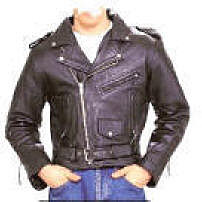
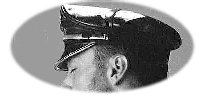 I went to Glennon's far more often as the 14th Street
Cafe spooked me because quite a few of the guys wore leather jackets, caps and
boots, and not being nearly as crowded as Glennon's the atmosphere felt too intense for
me. On the other hand, I remember that I did go home with guys from there on
two occasions. One them, Tony Montez, was a well-built, swarthy guy of
Mexican-Italian background, who talked out of the side of his mouth like a movie
gangster. He had an apartment in a tenement in a still Italian section of the
south Village, a neighborhood I'd never been in. While we never became close
friends, Tony was someone I'd hang out with if I saw him in the bars or at the
beach. Oh, he was also an "older" guy, thirty-five, maybe a bit
older.
I went to Glennon's far more often as the 14th Street
Cafe spooked me because quite a few of the guys wore leather jackets, caps and
boots, and not being nearly as crowded as Glennon's the atmosphere felt too intense for
me. On the other hand, I remember that I did go home with guys from there on
two occasions. One them, Tony Montez, was a well-built, swarthy guy of
Mexican-Italian background, who talked out of the side of his mouth like a movie
gangster. He had an apartment in a tenement in a still Italian section of the
south Village, a neighborhood I'd never been in. While we never became close
friends, Tony was someone I'd hang out with if I saw him in the bars or at the
beach. Oh, he was also an "older" guy, thirty-five, maybe a bit
older.
The 14th Street Cafe was the first place I was ever in that could have been called a leather bar. Judging from the fact that a fair number of the guys, as I recall, were fitted out with boots, wide belts, jackets and caps of leather, and that they seemed to be familiar with each other, I would guess there had to have been other bars like this one before that I simply hadn't heard about. Quite likely, as the people I had met in '59 would definitely not have been interested. (The Big Dollar, based on one brief visit, would have been a likely candidate.) About 1963 a bar opened in the West Twenties or maybe it was the Thirties, called the Exchange - from its proximity to a major telephone building - and it certainly attracted a leather crowd.
These were the years when you might come upon your most recent "favorite" bar (out of 2 or 3 open) and find a large sign in the window saying RAIDED PREMISES BY ORDER OF THE NEW YORK CITY POLICE DEPARTMENT. What to do? At one time the answer would have been to go somewhere else, but when there only were one or maybe two others, and they were not necessarily anywhere nearby it wasn't that simple any more -- particularly if you were literally counting your nickels and dimes like I was then. I can remember the first time I screwed up my courage to go in anyway, but that was because I saw a few other customers through the window. It was about this same time, and was a place around Sixth Ave. and 57th St. A bored cop sat inside and there were a dozen or so customers. There was a lot of forced humor and not much fun, and early home or to one of the meat racks to cruise. In a few days or maybe weeks (if they were luckier) that bar would be padlocked and that was the end of it. Then you would hear of another one.
GETTING TO KNOW YOU
As much as my work schedule interfered with a normal social life, the kid-in-a-candy-store mentality of a young male in New York certainly contributed to making some contacts one-off tricks too. If I didn’t meet anyone from the scads of incognito movie stars and celebrities the college clique had told me populated the gay subculture, I did learn in a latter-day expression that “we are everywhere.” I can recall being a bit surprised by this, which maybe is an indication that I had accepted the stereotype that gay men were mainly to be found only in certain occupations, i.e. – hairdresser, interior decorator, dancer and so on.
Deke was a young English exec, who passed through the city several times on his way between the UK and Brazil. Eddie was a free-lance accountant, who introduced me to the film and soundtrack of Black Orpheus – and, thus, to Brazilian music, which eventually became a passion of mine. Bill, was a Greyhound Bus dispatcher, Stan a fireman and Paul a policeman – who picked me up on Central Park West as he was going home after his tour of duty. Sid, a cute man - in his late 30´s it turned out (gasp!) - was a merchant seaman; a Mohawk-white mixed blooded guy, George, was an airline steward (no flight attendants then) from Canada. The incredibly built, Merle, designed sets for television and the theatre, and was a kind of 60’s NYC gay muscle celebrity - and as I found out later when I went to Fire Island, he was king-of-the-roost in a house bodybuilder roommates in Cherry Grove, and guys would make up a reason to take the walk their house was on to see if they were exercising out on the deck.
I met a couple of guys who were very nice and had their own odd schedules which dovetailed with mine, and I saw each of them for awhile.
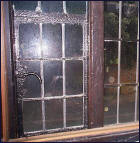 Bob
Glock lived in the
village
in a very old one and quirkily laid out
building, on Cornelia Street. It was tiniest studio apartment I have ever
seen.
After getting off at the Times early in the morning, I
would take the subway downtown, get a couple of greasy burgers with onions and
two Cokes at Riker's on Sheridan Square and then go over to his place.
He’d put on some Billy Holiday LP’s and we'd have sex. His place was so small we had to sit on
the bed and use the window sill for a table while we ate our post-screw burgers.
The garret-like room, with a candle burning on the dresser, and old fashion
casement windows overlooking a paved courtyard made me feel like I was in Paris
not New York. Whenever I hear Billy Holiday singing
If the Moon Turns Green, I think of Bob, so perhaps it was a favorite of his.
Bob
Glock lived in the
village
in a very old one and quirkily laid out
building, on Cornelia Street. It was tiniest studio apartment I have ever
seen.
After getting off at the Times early in the morning, I
would take the subway downtown, get a couple of greasy burgers with onions and
two Cokes at Riker's on Sheridan Square and then go over to his place.
He’d put on some Billy Holiday LP’s and we'd have sex. His place was so small we had to sit on
the bed and use the window sill for a table while we ate our post-screw burgers.
The garret-like room, with a candle burning on the dresser, and old fashion
casement windows overlooking a paved courtyard made me feel like I was in Paris
not New York. Whenever I hear Billy Holiday singing
If the Moon Turns Green, I think of Bob, so perhaps it was a favorite of his.
He and I went to see A Death in the Family. (While the ticket was a bit of a stretch for me, theatre was still affordable for most people in these years. Broadway was thriving, new dramas and musicals as well as established hits were abundant.) Once he came up to my apartment and played Blue Prelude (or was it Prelude in Blue) on Milton's piano. Ten years later on a Sunday afternoon, Santo, a guy we knew from the local bar took a gang of us on a tour of downtown gay bars in his Caddy convertible. We hit some spots around West & Christopher, one was Peter Rabbits - right around tea dance, the music was top-notch and there were two or three drag queens who were a lot of fun. Last stop on the way uptown was the Eagle. Bob was a bartender, or at least working there. He was slightly huskier, but otherwise looked much the same, and he still had his beautiful head of soft blond hair that looked like a mane of silk thread.
A little later, or perhaps even a year or two later, I met Eddie LeMans. On first take he was rather odd looking, a slender fellow with a head that was quite definitely too large for his frame. The fact that he had lost most of his thin blond hair from the front of his head further accentuated his bulging forehead. However, any impression of unattractiveness vanished when he smiled. Eddie hardly ever just plain ol’ smiled. His usual smile was a beaming grin, and matched with his big, pale blue eyes, which always looked a bit lost in dreamy melancholy, meant that he was as irresistible as a puppy. And he was a gentle guy, seemingly without a mean bent in his disposition.
He played the trumpet for
a living. It was a rather catch-as-catch-can existence, as I recall, though he
did play a loose circuit of bars and clubs with varying combinations of other
musicians. I never saw him on a gig, but I did hear him play anyway.
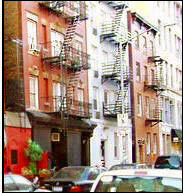
Eddie lived in a walkup apartment on Sullivan Street. You entered a large kitchen, where the fixtures were bunched into one corner to make room for the bathtub, and there was an old table and two wooden chairs. A window opened onto a large air shaft or perhaps it was an alley. In the front, street-facing, room there was a mattress on the floor.
Sullivan Street
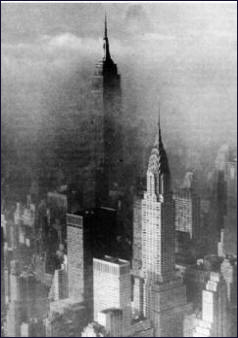 That summer it was hot and
steamy as a crotch. I’d wake up in the morning soaking wet, the air already
yellowish-grey with humidity and pollution, and Eddie would have left a tired
old electric fan aimed so it was blowing hopelessly across the mattress. Each
morning, for the first few moments, I was immediately miserable, and primed to
be pissed at the world; then I would hear Eddie playing very softly in kitchen,
and I’d lie there and listen.
That summer it was hot and
steamy as a crotch. I’d wake up in the morning soaking wet, the air already
yellowish-grey with humidity and pollution, and Eddie would have left a tired
old electric fan aimed so it was blowing hopelessly across the mattress. Each
morning, for the first few moments, I was immediately miserable, and primed to
be pissed at the world; then I would hear Eddie playing very softly in kitchen,
and I’d lie there and listen.
(right) 1963 smog pollution - not retouched. (AP photo)
How good a trumpet player he was, I don’t know. The names of the clubs he played in meant nothing to me, but perhaps they were not totally insignificant in the world of jazz aficionados. His playing was light and clear, always just a bit sad – I thought – and a little “sweet” too, or sentimental, maybe. He liked Chet Baker’s playing, could be it influenced his own. A long time latter I got interested in jazz and picked up on Baker myself; so much time had passed it seemed just like Eddie again to me.
When I got up and went out in the kitchen, Eddie would be sitting at the window in his undershorts, usually playing with a mute on his trumpet. He would make coffee, always instant, always awful. We’d take the cover off the tub and have a bath together. It was sweet and romantic, but it was almost a necessity. The water pressure was so terribly low that it took forever to fill the tub a few inches, but with two of us in it the water rose to a level that promised the possibility of a real bath.
Seemed like when we left the building everyone on the street knew Eddie and said hello, and the neighbors evidently didn’t mind his playing. One beastly hot morning a woman was sitting on a folding chair in front of the building next door, sweating and fanning herself with the Daily News. As we passed she said something like, “That was nice today, Eddie. Real pretty.”
After I left Eddie in the morning I'd hang around the Village and browse in a branch of the Marboro chain of book stores on Eighth St., or in the Eighth Street Bookshop on the corner of MacDougal, where I saw Allen Ginsberg once. (The latter place was a regular shopping magnet for many literary celebrities of the day, though I wouldn't have recognized most of them.) The Village Squire, the "faggy" clothing store that had advertised on the back pages of Esquire (and whose catalog mailing list I joined in college, mainly for the drawings) was still on the north side of the block, though the string of gay bars - the Old Colony, Main Street and Mary's- was closed. Then I'd catch the IND 8th Ave. uptown at 8th St. and Sixth Avenue, which was - like Sheridan Square further west - a Village crossroads. The Women's House of Detention was on one corner (where a garden is now), the churchy-looking Jefferson Market was next to it, and around behind them the old Village "plague alleys," Patchin Pl. and Milligan Pl. Across from the prison was Sutter's bakery (my introduction to the French cruller) with the Village Voice offices above it.
One other encounter was surprising. I was at Glennon's bar and as I was
leaving around closing time, a stranger handed me a card and said something
like, "Stop by." It was for a place called the "Coat of Arms" with an
address on upper Broadway somewhere, and it was open after bar hours. As far as
I can recall, this was the first illegal after-hours place that I'd heard of.
When I got back uptown to my apartment I looked at the card again and realized
that it was very close by. I walked down Broadway, checking the numbers,
and was surprised to find that the address
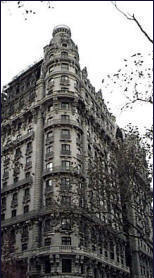 was the grand old Ansonia apartment
building! This made me a bit nervous. (What I didn't know then was
that the Ansonia was far less classy than it's appearance suggested.) The
lobby was empty and I went up to the floor indicated and found the door - the
same card was thumb-tacked next to the buzzer. I paid a small fee to get
in. The bar was the kitchen counter. There was a bed room in the
back, which was being used for sex I saw when I went to the bathroom later, and
a handful of guys were sitting around in the living room.
was the grand old Ansonia apartment
building! This made me a bit nervous. (What I didn't know then was
that the Ansonia was far less classy than it's appearance suggested.) The
lobby was empty and I went up to the floor indicated and found the door - the
same card was thumb-tacked next to the buzzer. I paid a small fee to get
in. The bar was the kitchen counter. There was a bed room in the
back, which was being used for sex I saw when I went to the bathroom later, and
a handful of guys were sitting around in the living room.
The Ansonia Apartments
One of them was someone I'd gone to school with! Ted had left not long after he reached the legal age of sixteen, and I had never seen him since. That was five or six years ago, but he looked pretty much the same. He was a mixture of white and Native American, with a slightly ruddy complexion and reddish blond hair. He still had a hard, muscular body, which people said came from the fact that his father was a mean bastard who beat his kids and worked them like they were animals on their farm. Ted had been a terrible student, and very much of a brooding loner that most kids walked around. It was obvious in gym class that he was immensely strong, and if he was antagonized he was a maniacally ferocious fighter, so even the biggest bullies stayed clear of him. I discovered one day while we were standing around in the dark watching a movie in shop class that the kid who had first seduced me was up to something. I reached over and discovered that he had unbuttoned Ted's fly, and was playing with Ted's rock hard dick.
It was five or six years since we'd last seen each other in our little hometown, and we were both surprised - and the other guys were curious. He was friendly enough for Ted, though clearly ill at ease, but neither was I as the guys sitting around didn't disguise the fact they were listening. I called him a couple of times at the fleabag hotel in our neighborhood where he'd told me he was staying. But he clearly had zero interest in meeting again. I wasn't yet very savvy about anything that wasn't pretty much white bread gay life. But after I thought about the evening, a few things sunk in. The two guys who were running this "club" were both wearing a little leather, and I'd noticed a couple of leather jackets slung on the backs of chairs. The guy who'd handed me the card in Glennon's could have come over from the 14th Street Cafe, which got a leather clientele. Ned's interaction with one of the guys who lived in the apartment, I'd noticed at the time, had been peculiarly subservient for someone with Ned's temperament. Maybe he'd found a kind of ritual replacement for his father in a leather crowd.
I never ran into Ted again.
Probably the most important guy I met was Arthur, a Jewish guy who worked in his family's business in the garment district - "the most important" because it was through Arthur that I began to have a circle of friends and a regular social life. Arthur and I met and tricked one time, but we hit it off as friends. He lived on West End Avenue, in a better part of the neighborhood. He took to calling me whenever his friends were coming over or going out as a group, and it was a contact that lasted even though I wasn't working normal hours yet. Arthur was a native New Yorker, and his circle of friends - with the exception of his best friend, Greg Stone - were Jewish, and born and raised in the city or its suburbs. Listening to them talk about growing up and their family life was an intensive course in Jewish New York. New York City had the second largest Jewish population of any city in the world, and though it had at one time been considered an "Irish city" (even when the Italians had come to form a large part of its Catholic population), this had been changing for decades and was to climax in the late Sixties. Much of what was pervasively and distinctly New York in the way of food, slang, humor and spirit was derived from the Jewish - and more specifically perhaps, Yiddish -- background of people like the grandparents and parents of Arthur and his friends. And the slang and humor found a place in the gay subculture of the city.
THE TIMES AND TIMES SQUARE
While the copy boy/clerk job consisted of nothing more demanding nor interesting than running pieces of copy to the various news desks, with occasional jaunts to other parts of the building or outside, I didn’t find it boring at all. We were usually very busy, and the surroundings and the people were interesting. My peers were almost all grad students at the Columbia journalism school or recent college grads. They were a brainy, friendly bunch of guys, most of whom always brought a book to work. There was a lot of discussion about what guys were reading, and I’m sure this pushed me to fill in the many gaps in my education. I plunged into French literature with André Gide, Anatole France and François Mauriac - and the latter suggested a long detour through Graham Greene – usually reading three or more books by each author before moving on.
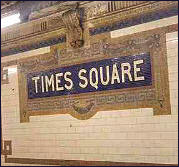 (right)
Times Square IRT station mosaic sign
(right)
Times Square IRT station mosaic sign
I came to work late in the afternoon or early in the evening, and I usually ate something at one of the cafeterias or cheapo hamburger stands on or near 42nd St. My earliest daytime impressions of the area were simply that it was terribly grubby and obviously a center for sleazy businesses. However, my lunch hour was late at night when the area was thronged. Also, one of our jobs was to pick up the latest edition of the other New York papers (there were seven back then), plus the Wall Street Journal, the Sporting News, and other specialty publications. First stop was a newsstand on the corner of Seventh and Forty-First in front of a theatre that showed “girlie movies,” then around the corner and downstairs to one in the Times Square station of the IRT subway – and that place looked liked Hell’s waiting room after sundown! These night time trips outside introduced me to a Times Square/42nd St. that was garishly lit, noisy and even dirtier than in the daytime, and thronged with people leaning against the store fronts, hanging out around the all-night movie houses or sauntering up and down as if it were the Fifth Avenue Easter Parade.
 Times
Square dining, 2 for 25 cents burgers and franks (photo: Klaus Lehnartz)
Times
Square dining, 2 for 25 cents burgers and franks (photo: Klaus Lehnartz)
To get off the street on my late night lunch hours I often went into some of the many stores that sold back-dated magazines, old paperbacks and racks of mostly grade Z current paperbacks. The array and amount of old magazines was fascinating, and there were always many beefcake mags going back to the early Fifties to entertain me – if another copy boy wasn’t with me. One night, having forgotten to bring a book to work, I was doubtfully browsing and lingered over a paperback with only a mildly erotic cover. After skimming, I decided that it was probably going to be the best of a not terrific selection, and I would take a break from culture. The author had a Japanese name. While I had taken a very short survey course at Syracuse on Japanese culture and history, I’d never read any Japanese literature. I read the book at work and enthused over it as one of the greatest things I had ever read. No one had ever heard of it, no one would read it because of the silly cover, etc. Eight years later the author won the Nobel Prize for literature. He was Yasunari Kawabata and the book was Snow Country. (Unfortunately I had not kept in touch with any of these guys, and was not able to thumb my nose and say, nyah-nyah!) I went back to the same store and after a lot of searching came across another paperback by a different Japanese author, Some Prefer Nettles by Junichiro Tanizaki. These finds were the beginning of a fascination with Japanese culture (especially literature) that was to be a major interest for the rest of my life. Another find in the same store was a copy of Gide’s Corydon, his apologia for homosexuality. The title only caught my eye because the work had been very gingerly referred to in the prefaces and introductions to his novels that I’d just recently read, so the odd word had stuck in my mind.
So, in at least two cases even sleazy Times Square made a high-brow contribution to my remedial education.
Once
in awhile it would be my job to “clean the spike” in the Times newsroom.
This was a long spindle on which the PR releases, newsletters, etc. that came
into the paper ended up. One night I came across a release from the Alcoholic
Beverage Control Board naming bars that had been closed for legal violations.
This became my printed introduction to myself as I was perceived by the law.
Glancing down the list, I came across a place that had been closed for
“congregating homosexuals,” and it went on to indicate that their activities
were “immoral” and “undesirable.” In some strange way this was more repellant
and intimidating than the presence of a policeman sitting in a raided bar. This was the
great, all-powerful They talking, making its supreme will known in print. This
couldn’t be brushed off as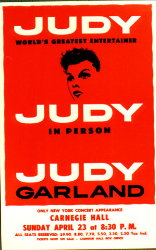 the occasional crooked guy in blue on the take or a uniformed bully getting his
jollies through intimidation on a whim. This was The Law. And, clearly,
to be what I was put me unmistakably outside the Law. Whenever I would clean
the spike after that, I would peruse this list if I found a copy, searching for
notices of closed gay bars. But from that time on I was always very careful
that no one saw me reading that list, so I would not run what I saw as the
dangerous risk of being asked why I was interested. It was as if I would be
assumed guilty of something just by reading the list, as I knew why I was
reading it and I knew “what” was reading it.
the occasional crooked guy in blue on the take or a uniformed bully getting his
jollies through intimidation on a whim. This was The Law. And, clearly,
to be what I was put me unmistakably outside the Law. Whenever I would clean
the spike after that, I would peruse this list if I found a copy, searching for
notices of closed gay bars. But from that time on I was always very careful
that no one saw me reading that list, so I would not run what I saw as the
dangerous risk of being asked why I was interested. It was as if I would be
assumed guilty of something just by reading the list, as I knew why I was
reading it and I knew “what” was reading it.
The homophobia of the New York Times in this era is regularly invoked by gay commentators, as if it were something especially bad. I find it difficult to connect with this, and I wonder if their chagrin isn’t an unreasonable reaction to the fact that today’s liberal Times could have ever been a horse of another color. I did not experience the Times as a especially homophobic environment as everything was homophobic. Homophobia was thoroughly worked into the fabric of American society, to expect the Times to have not been part of that strikes me as naïve. Homophobia was the norm, and that norm was not being seriously questioned nor eroded in public life.
Judy Garland appeared at Carnegie Hall on April 23, 1961 and gave what was probably the best concert performance of her life. I had to work that night. With very little effort I could be pissed at the Times over this.
By spring I'd gotten over enough of my skittishness about
Forty Second Street to hang out there for a little bit sometimes when I got off
work in the early morning hours.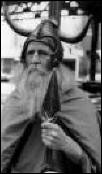
Hubert's Flea Circus was on the south side of the block
between 7th & 8th - a freak show, game arcade and junk souvenir
emporium. There was a strongman there who sometimes seemed to be checking
out the guys in the crowd. Several times I saw a woman walking on 42nd
Street with her lower faced covered by a crisscrossed
scarf. She was, I was told, the bearded lady taking a stroll between shows. There's an
interesting book, Up in the Old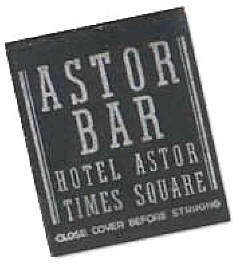 Hotel, a collection of off-beat New York vignettes, and one of them is about
Jane Barnell/Lady Olga a famous bearded lady who had worked at Hubert's -- and
perhaps the woman pointed out to me was simply a misplaced historical memory of
her. Hubert's was quite strange, the customers more than the attractions.
And then there was Moondog, the blind "Viking" street musician just
north of the Square.
Hotel, a collection of off-beat New York vignettes, and one of them is about
Jane Barnell/Lady Olga a famous bearded lady who had worked at Hubert's -- and
perhaps the woman pointed out to me was simply a misplaced historical memory of
her. Hubert's was quite strange, the customers more than the attractions.
And then there was Moondog, the blind "Viking" street musician just
north of the Square.
Up at the other end of the block was Grants, a bar lit up like -- well, Times Sq. -- and open to the street with racks and racks of hanging dispensers of rotgut booze, some it was 35 cents a shot. You could get shitfaced for a buck forty on an empty stomach. A small draft beer was fifteen cents, I think ... sometimes I got treated to drinks. Usually these guys were more lonely than hungry for sex.
And then there was the Astor Bar, if you had a suit to wear -- but my impression was that its days as a pickup bar had passed.
Working in the newsroom, even as just a copy boy or a slot clerk, was interesting and sometimes really exciting. The election night race between John F. Kennedy and Richard Nixon in November 1960 was one such event, and it still wasn't decided when I was finally let off in the early hours of the morning. Another exciting cliffhanger was the French army mutiny in Algeria in late April of the following year, when it looked at one point as if parachute troops from the rebel army in Algeria would be dropped on Paris.
IN THE GOOD OL' SUMMER TIME
Milton had a brief spell that winter as the musical director of an Off Broadway project based on an updated version of the Greek legend of Medea. Uh huh. It lasted one night at the Cherry Lane Theater - and tying together one of its ragtime numbers and the plot, the Times critic labeled it the "tiger hag." So after some coaching work, Milton got a job as a musical director on the Lenny-Debben straw hat circuit and was gone for the summer of '61. Whoopee! And I was free to cavort in our shared bedroom without having to worry about disturbing my roommate in the other bed, or else asking my trick to bang on Milton's mother's old couch in the living room like teenagers humping in the back seat of a '52 Chevy.
And I finally encountered the infamous Neisseria Gonorrhroeae. Not a dissolute movie star from the exotic East, alas, but an entity more familiarly known as the
"clap."
And there it is!
Most men were not real happy about going to their regular GP with a case of venereal disease, much less to a public health center. There were, however, several gay doctors who were known (a bit ungratefully under the circumstances) as "clap doctors." The two most well-known ones in the early Sixties were both Dr. Brown - Eugene and Clarence. The former was an attractive young man, occasionally seen at the baths; the latter was a balding, middle-aged man with wire rimmed glasses and a pink cherubic face.
BY THE SEA,
BY THE SEA, BY THE BEAUTIFUL SEA
Part of
the gay section at Jones Beach, 1959 or '60. Riis Park with bath
house towers in mid-distance,
gay section of beach was beyond it in farther
distance.


New York baked during the summer - and it was years before I could afford to buy a/c for any apartment I lived in - but there were two gay beaches within a relatively short distance of the city (i.e. Manhattan.) The one at Jones Beach was far less accessible because it required a car, but the one at Riis (pron. reese) Park between Fort Tilden and the Rockaways, could be reached from Manhattan by subway and bus.
The trip from the Upper West Side on the IRT #2 train, the Flatbush Express, out to the end of the line in Brooklyn was long and boring. After the train left Manhattan and crossed under the East River, it arrived at the Clark Street station in Brooklyn Heights. In the summer of '59, before I'd ever had a reason to come over here, I'd heard that the Promenade above the river, which faced the skyscrapers of Manhattan's financial district, was a popular cruising spot. The St. George Hotel had been known for its gay action, and there had been at least one gay bar in the neighborhood. After I moved to the city, when I'd needed a dentist in an emergency, an acquaintance had sent me to his located over in Brooklyn Heights. (I thought he must be kidding - Your dentist is way over there! He worked in downtown Manhattan, so it was really not at all remarkable - but such was my idea of Brooklyn.) Later I'd bumped into a guy who'd been at Syracuse U. when I had, and we tricked a couple of times, going back to his place on Pineapple Street in Brooklyn Heights a few blocks from the Promenade. The Heights was a lovely neighborhood, a bit like quieter parts of Greenwich Village – but more attractive, and smaller and far less commercial.
It was also located on the edge of terra incognita as far as my knowledge of Brooklyn went. As the train roared on, the stations clipped by – Borough Hall, Hoyt St., Atlantic Ave., Bergen St. and on and on and on, prosaic enough names, but they could have been stops on the Silk Road for all I knew about the territory we were passing through (under, actually.)
About the natives I knew a bit more, but not much. The legendary Brooklyn Dodgers – famous as "dem bums" – had been the home team for seventy-four years, before decamping to L.A. in 1957. Walt Whitman, a native of Long Island and Brooklyn, published his revolutionary volume of poems, Leaves of Grass, on Fulton Street in 1855 – "Song of Myself," "I Sing the Body Electric," etc. – and celebrated the lads of the city, sometimes passionately, for the rest of his life. And in the early Sixties unusual and high quality photographs featuring Brooklyn young men, and credited to Les Demi Dieux, were appearing in the large format, glossy physique magazines, Demi Gods and Young Physique. (For a brief page with info on Whitman, and photo galleries of the work of Danny FitzGerald/Les Demi Dieux and vintage candid shots at Coney Island beach by Edward Melcarth follow this link.)
Forty-five minutes later we reached the last stop, and rushed upstairs to catch the city bus for the twenty-minute ride that ran through Flatlands - and probably over the fields of one of my mother's colonial Dutch ancestors - past Floyd Bennett airfield, across the bridge to the borough of Queens and the long, low-lying barrier island where Riis Park beach was located - and beyond it the Rockaways. Finally!....Riis Park
The gay section of the beach was at the very eastern end at the point where the wooden boardwalk stopped, and away from the bathhouse with its locker rooms, toilets and concessions. Perhaps because you had to leg it back to the bathhouse conveniences, plus the fact that this section had the reputation of having more blacks and Hispanics, it was ordinarily less crowded and, thus, free of an annoyingly high number of straight voyeurs. Though the beach is actually within the city limits, when I first went there (summer of '59) the gay end of the beach still had the pathetic last trodden down remnants of a sand dune.
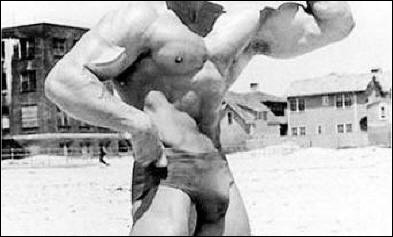 (right) Abandoned hospital
in left background, Belle
Harbor orthodox Jewish
vacation houses in right
background. Hunk in
foreground.
(right) Abandoned hospital
in left background, Belle
Harbor orthodox Jewish
vacation houses in right
background. Hunk in
foreground.
There was an abandoned hospital behind the far end of the beach, and it saw some use for sex. Cruising on the beach was usually conducted at a deliberate pace calculated to fill a lazy afternoon, but it accelerated back in the bathhouse locker rooms, and on the bus and subway trip returning to Manhattan the tension could be worthy of the best Hitchcock film.
A very high and sturdy wire fence separated this end of the beach from the houses and beach of the Belle Harbor neighborhood. Right next to this barrier on the Belle Harbor side was a group of large clapboard houses that catered to a summer clientele of orthodox Jews. Women were rarely seen, but men would sit on the front porches, dressed in their heavy black clothes, holding their prayer books and rocking back and forth as they davened. Considering the Book of Leviticus, it was an ironic juxtaposition.
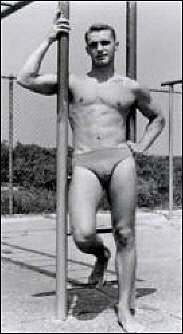 While
no one would have mistakened the gay section of Riis for Cannes, the men showed
considerable enthusiasm for peeling down in the direction of Riviera standards.
Most American men during the Fifties and early Sixties wore the boxer shorts
style of bathing trunks similar to what was worn in gym classes, a lesser number
wore the skin tight style called briefs, though these briefs, the waist of which
usually began about a daring inch below the navel, were certainly brief in
relation to the boxer style which could look like you were wearing a two-legged
tent.
While
no one would have mistakened the gay section of Riis for Cannes, the men showed
considerable enthusiasm for peeling down in the direction of Riviera standards.
Most American men during the Fifties and early Sixties wore the boxer shorts
style of bathing trunks similar to what was worn in gym classes, a lesser number
wore the skin tight style called briefs, though these briefs, the waist of which
usually began about a daring inch below the navel, were certainly brief in
relation to the boxer style which could look like you were wearing a two-legged
tent.
The maximum coverage bathing suit, Riis Park style. The guy is Lance Willet, a member of the Coast Guard and a Fifties beefcake model. The photo is by Champion, a NYC photographer, probably taken at Riis Park or Jones Beach. This particular style of suit in the same thickly woven fabric (which doesn't doesn't show in the reduced photo) and minus a built-in supporter, was a staple item in the inventory of the Village Squire and similar gay-oriented stores.
Boxer shorts style suits were sighted at the Riis Park gay beach only a little more often than the whooping crane. The standard bathing suit was a brief that rode across the hips and had high cut leg openings, like those seen on bodybuilders of the era, and some guys wore skimpier suits which started just above the pubic hair. The police came down to the gay area sometimes and gave summonses to men who were on the boardwalk in bathing suits that violated the law. I haven't the slightest idea what constituted the legal minimum coverage, and no one was ever ticketed while on the beach itself, as far as I know.
The beach was not well cleaned up in the first few years I went there, but the water usually looked to be at least tolerably clean. (Let me revise that, the water looked fucking wretched compared to the upstate lakes I was used to - or Florida beaches, but the entire metro environment was pretty scuzzy at this point, and I quickly adjusted my standards. So, while the water was often cloudily grey with pieces of paper, orange peels and condoms floating in it, I never saw sacks of drowned kittens or turds bobbing in the waves.) By the late Sixties the wooden boardwalk had been replaced with a concrete promenade, the sand was being raked clean of litter by large machines and a refreshment stand with public toilets had been constructed at the gay beach. In a playing field immediately behind the refreshment stand dykes played baseball - occasionally joined by a group of guys clowning around. The number of blacks and Hispanics, both gay and straight, in and around the gay beach area increased toward the end of the decade.
In the early Sixties physical fitness was just beginning to creep into the public consciousness, and bodybuilding was still pretty much for weirdos only. Even among gay men gym memberships weren't taking a bite out of many wallets yet, and when they did "the gym" was almost always just the Y and a routine of free weights. The few worked out bodies at Riis Park were like a constellation of beach gods. And to many gay men who spent their summers going to Riis Park, they were as immediately identifiably fully dressed on the streets of Manhattan as if they had been celebrities. It was axiomatic though, "They're only interested in each other." It was also axiomatic that "they all have small cocks." (Both statements were based on insufficient research, I later discovered.)
One afternoon I was standing at the edge of the surf, finishing a cigarette
before I went into the water. Someone standing a little behind me tapped
me on  the
shoulder. When turned toward him I almost pitched into cardiac arrest because of his uncanny resemblance to a spectacular
50's beefcake model, Joe Survilas. (And if you had to look like somebody,
you'd really lucked out in this case.)
the
shoulder. When turned toward him I almost pitched into cardiac arrest because of his uncanny resemblance to a spectacular
50's beefcake model, Joe Survilas. (And if you had to look like somebody,
you'd really lucked out in this case.)
(right) Joe Survilas, photo by Joe Corey
He held out an unlit cigarette and smiled, I held out my cigarette, and he cupped my hands in his while he got his light. The music I was hearing in my head was later used as the signature for Space Odyssey 2001, or perhaps it was just the sound of a spectacular rise in blood pressure. He smiled, I probably salivated...but: They are only interested in each other. I turned around, took a final drag on my cigarette and walked into the deep water. As far as my friends were concerned when I came out and went back to our blanket, I should have just kept on walking, on and on - like Joan Crawford or whoever it was in some old movie - until the water was over my head. In their version he had been walking along, stopped to look at me and then come down and stood near me, moving closer several times as I didn't notice him, and finally had resorted to asking for a light. Hey, it's not like I had eyes in the back of my head, besides they are only...etc.
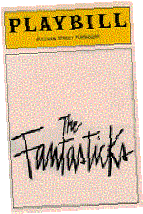 Fate
allowed lightening to strike a second time. The following spring I ran
into him again in the city, and we went to his place. This time
performance anxiety made the sexual fireworks spectacularly unspectacular, but
he didn't make a big deal out of it and I stayed the night. His name was
Tony, and contrary to what his smoldering Italian looks and muscled physique suggested
he was a soft spoken guy, who wrote and reviewed children's books. In the
morning he put on some of his favorite music, the cast recording of the Off
Broadway musical The Fantasticks. When I said that I hadn't seen
the show or even heard the music before, he insisted I sit and listen to it all
the way through. The
Fantasticks had opened in 1960 and didn't close until 2002. So many
gay actors played a role in it over the years that eventually it seemed like everyone could say he
had tricked with, been a boyfriend of or friends with "a guy in The Fantasticks." And that includes me. But I always associate the music with that spring
morning, sitting by a window with a slice of a view of Central Park while a very
pleasant and unassuming "Beach God" introduced me to this beguiling
musical.
Fate
allowed lightening to strike a second time. The following spring I ran
into him again in the city, and we went to his place. This time
performance anxiety made the sexual fireworks spectacularly unspectacular, but
he didn't make a big deal out of it and I stayed the night. His name was
Tony, and contrary to what his smoldering Italian looks and muscled physique suggested
he was a soft spoken guy, who wrote and reviewed children's books. In the
morning he put on some of his favorite music, the cast recording of the Off
Broadway musical The Fantasticks. When I said that I hadn't seen
the show or even heard the music before, he insisted I sit and listen to it all
the way through. The
Fantasticks had opened in 1960 and didn't close until 2002. So many
gay actors played a role in it over the years that eventually it seemed like everyone could say he
had tricked with, been a boyfriend of or friends with "a guy in The Fantasticks." And that includes me. But I always associate the music with that spring
morning, sitting by a window with a slice of a view of Central Park while a very
pleasant and unassuming "Beach God" introduced me to this beguiling
musical.
Riis Park was not the paradise that was Fire Island certainly, but for those not able to make it to the storied "Island" it served as a kind of raffish substitute. Despite the crowds, the long subway ride and the far from pristine beach and water - and cruising aside - Riis Park was just plain fun. If you were young, and gay and not very flush with money, it was a great place to hang out on summer weekends with your friends - and I went there for the rest of the decade.
UNCLE SAM GETS AN ATTITUDE
In spring of '61 my parents notified me that I had received my notice at my
former home address to appear before the draft board for a physical examination.
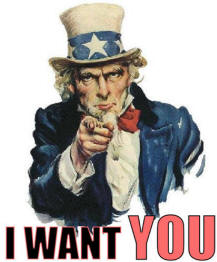
In this era when American teenage males reached the age of eighteen they were required to register for classification with their local Selective Service Board, usually referred to as a Draft Board in a throwback to WW II terminology. A two-year stint in the armed forces was compulsory, and those who did not enlist in one of the other services got drafted into the Army. Young men who were accepted for college received student classification which kept them out of the draft until they were graduated or left school for other reasons. The rest found themselves inducted into the Army in relatively short order, unless they were found to be unfit for service.
What to do? Not about the physical exam - failing to respond to the notices of the Selective Service was a serious crime - but about answering that question. The question was the one which asked if you had had any homosexual experiences. (Actually I am no longer certain, though it was always referred to as if there were a single question, there may have actually been two or three about to homosexuality.) Not to declare your homosexuality and have it discovered later meant a dishonorable discharge from the service, which was a damning mark against you and one that was likely to blight the rest of your life. On the other hand, to declare oneself during the physical meant a 4F classification - unfit for military service.
I returned upstate for the physical and on the appointed day found myself, along with half a dozen high school classmates and dozens of strangers, herded through the examination as a group. At the end we were seated at tables to complete questionnaires about our health, and much to my discomfort my old classmates and I all sat together. I had not in the weeks leading up to this day been able to make up my mind what I should do. Madly, wildly I had hoped that something - Armageddon, anything - would occur to rescue me, and when I reached that question I was a wreck. The time was ticking away, and the question, as I recall, was near the end of the form. I hunched over my paper to hide it from any former classmate. I was terrified that a "yes" response might get me denounced in front of everyone, and the news carried back to my hometown where it would humiliate my parents. I made a check next to, but outside of the "yes" box. Then I thought that the sergeant who had honchoed us through might ask me in front of everyone what the fuck box I had intended to indicate. God, no!! I erased the check and moved it not exactly into the box, but touching one edge of it. No, I knew that was just as bad. Whatever I did I ran the risk of public humiliation.
But no matter what, I already knew that as a gay man I would face a lifetime fearing discovery and ruin. The very nasty run-in with the cops in the raid on the Mais Oui during my first visit to NYC had confirmed the worst. And by now I knew how prominent the anti-gay witch hunt was in the McCarthy years. And then there was my parents' hateful reaction based on total ignorance and a determination to stay that way -- if that was parents, what would come from the rest of society? I was seething with accumulated resentment. Why should I serve a country, much less die for it, when in return it criminalized my very existence?
Screw it, I erased the last check mark I'd made - and made a new one inside the box where it belonged.
(In later years I wondered how many guys who checked "yes" had also surrounded the box with grubby erasures of trial attempts.)
After the forms were collected I, and several other guys were called together to talk to the sergeant. Some were asked for medical documentation, others - including me - were simply told that they would receive a notice for a further exam. And that was that. No fuss, blessed relief. A week or two later I received a card to go back upstate to the center. I was given the address of a doctor and directions to his office. As I expected, he was a shrink. After waiting a few minutes in an empty waiting room, he appeared at a door and motioned me into his office.
There were a few curt preliminary questions. I'm not sure, but he may have then asked me why I was there, putting me into the position of raising the subject of my homosexuality - when clearly he would know exactly why I was there. In any case, the foreplay was quickly over and we rushed to a climax, so to speak.
"What makes you think you are homosexual?" he asked.
"I don't think I am, I am homosexual."
"Tell me what do you do with men then?"
 And I did. (Being quite scared, I'm
certain I did not break into an aria
on the joys of anal sex, but you would have thought I had.)
And I did. (Being quite scared, I'm
certain I did not break into an aria
on the joys of anal sex, but you would have thought I had.)
"You don't think you can do that in the army do you!" he shouted
"Well, I guess I'll have to cross that bridge when I come to it."
"GET OUT! GET OUT OF MY OFFICE!!!!!"
When I fled into the waiting room a young black guy was there. He smiled weakly and rolled his eyes. I left, believing that Dr. Cool would classify me 1A out of vengeance, and that the stigma of having checked off the box would follow me until I was hounded out of the Army with a dishonorable discharge.
My next communication from Selective Service was a new classification card: 4F.
MY BRUSH WITH FASHION
Now that I was no longer Draft bait, I decided that I could look for a new job. The copy boy position at the Times didn't appear to offer any clear route to a better position there and the salary was low even compared to trainee positions in the classifieds, but more important was the fact that my personal life was in Limbo. After a year in the city I had barely begun to make any friends or have a regular social life. Though I'd met tricks on my nights off and some of them had become acquaintances, working nights and rarely having weekend nights off meant that I was out of sync with the normal nine to five world and most people's social routines. When I mentioned to Jack Robinson, a fellow I knew from the bars, that I wanted to leave the Times, he told me his assistant had left and asked if I'd interested in trying the job.
(right) Jack Robinson - self portrait
Jack
was a commercial photographer, I knew, but as he sketched the job out I realized
his work was exclusively in the area of fashion. He was a
low-keyed, affable guy in his thirties - with a hint of something like
wistfulness lurking behind this
demeanor - and though he'd always been friendly
when we ran into each other, he'd never shown any interest beyond that.
This seemed like a good start and the work environment promised to be far more
interesting than anything I'd be likely to find following up the "trainee
wanted" ads.
I quickly found out that Jack was far more successful than his unassuming manner suggested. Several ad agencies used him regularly on well-known brand accounts, and the fashion editor of the New York Times, Carrie Donovan, liked Jack's work and used him often. The "office work" end of my job involved booking models, locating props and arranging permission for shooting sites with the City or private companies or individuals; at the shoots I did everything from standing on a wall holding a flash to kneeling out of camera range pulling on an invisible thread to make sure a model's clothing looked suitably full.
Often I was intimidated by the models. Many of them, women and men both, seemed to maintain a cool distance, whereas everyone else at a shoot, regardless of where they were on the ad agency or client totem pole, was usually fairly informal. My sense of awe was shattered early on. Jack's studio and apartment were a duplex in an unassuming old building on East 10th Street in the Village. One afternoon after the model and the ad agency's guy had left, Jack invited the advertiser's fashion director downstairs to his living quarters for a drink and I was included too. I was not particularly comfortable, feeling rather like a student sitting in the Teacher's Lounge for the first time, especially as the fashion director looked and acted considerably more glamorous than the model had. Jack remarked how this particular model - who was the favorite of a very famous designer - was always aloof, even though he'd photographed her many times. The fashion director protested : "Aloof? Oh noooo, it's just that she's as dumb as dog shit." Jack's expression didn't change, but mine must have, because he pointed at me and burst out laughing. The woman turned to me and said, "You'll find out. Wait until he invites one of them down!" Ave atque vale, glamour.
The job lasted less than a month. Though Jack maintained a casual tone at work, he was a stickler about dependability - and in a two-person operation he had to be as a matter of self-preservation. I, on the other hand, had a problem after a year of night being day of turning it back the way it should be. After several seriously late arrivals, Jack canned me. Despite that, over the next two or three years he was as pleasant as ever when I ran into him; then for awhile I was in and out of town on a job, and when I was back in New York full time I no longer ran into him.
Jack's star rose rapidly and high in New York. His work expanded to include jaunts to shoot high fashion collections in Europe, as well as sessions photographing political figures, film stars, singers and every major musician in the Sixties in the U.S. I found out later that his work had gotten him involved with Andy Warhol and his menagerie, and Jack's sadder and darker side succumbed to their lifestyle. His career and his life had skidded into a rapid oblivion from alcohol and drugs. He left the City in 1972 and led a reclusive existence in the South until his death in 1997. Years passed before I learned of this, but when I did it seemed as sad and unbelievable as if I were back in the Sixties. He was a good person, but as many of us learn that doesn't prevent you from screwing yourself over.
LARRY COULTER
If, as the saying goes, the wages of sin is death; then I learned that the wages of screwing yourself out of a good job is poverty. Having worked for Jack Robinson for only a few weeks, my Unemployment Insurance payment was derived as one-half of my weekly Times salary - $27.00 per week. For anyone who might think that in 1961 terms this was a pot of gold, get over it. This was New York, not Podunk - it was a bad as it sounds.
The first thing that went was sharing the apartment with Milton. My share would have taken more than two entire weeks’ Unemployment payments, as I recall. (I was certain the impact of living on $27 a week had registered, but I was, in fact, a total asshole at this point about what the reality of it would mean.)
I even had something like a sour grapes story to console myself with if need be: One hot Sunday afternoon in the past summer I'd turned on the radio as I came into the apartment from Riis Park. A newscaster was telling how the police were trying to break up a race riot just one block north. Several thousand blacks and Puerto Ricans on the street were ripping each other apart, and even throwing acid. The city cauterized the problem by tearing down a large part of the block in the following months and eventually erecting a new school - and the poverty-stricken people who lost their homes, angrier than ever, no doubt, just took their problems elsewhere, I guess.
I found a room in the Riverside Towers (think that was the name), a few blocks away in a slightly better part of the neighborhood. The place looked seedy-respectable, though I received a free supply of cockroaches along with sheets and towels. Eddie, a friend of mine stopped by, looked around the room and said nothing, just shook his head.
Beers in a bar were in the range of thirty-five to forty cents a bottle, so I figured my first Saturday night that I could afford three beers and a fifteen cent subway ride down and back. Surely this was Spartan rations at any income level!
I was invited to an after-closing party by Craig Patterson, a doctor in his late thirties who I knew from the bars, and his
lover. It was a fairly small group of guys, most of us sitting on a very long
L-shaped couch around a large square coffee table and chatting. I was talking
to Craig about a book or article I had just been reading on Japanese theatre. I
had been especially fascinated by the fact that they used reverberating drums
under the stage so that the actors’ footsteps could be
 enhanced.
Craig, an extremely nice guy, made out to be fascinated when he might well have
been bored witless, and perhaps this encouraged me. In any case, I slipped off
my shoes and stepped up onto the coffee table, which fortunately was a big
sturdy piece of furniture. Surely I could not have been drunk on three beers,
so I would like to assume that my enthusiasm for this esoterica, plus the
undivided attention of someone I respected a lot—and had a bit of a crush
on—turned me into the kind of dimwit who leaps onto tables to dance. I did not put on a lampshade nor
did I actually stomp around on his coffee table. Nevertheless, no
matter how you look at it, I was standing on the man's furniture and still
babbling my newfound knowledge of Kabuki or Noh drama while
looking down at Craig, whom, I can clearly recall, appeared hypnotized. (Of
course, he could have been horrified.) This prancing fool, however, was the same
jerk who had yet to grasp that on $27 a week you cannot live in even shabbily
respectable hotels and run out to gay bars, so perhaps my performance really was
prompted more by stupidity than a naïve enthusiasm for the arts.
enhanced.
Craig, an extremely nice guy, made out to be fascinated when he might well have
been bored witless, and perhaps this encouraged me. In any case, I slipped off
my shoes and stepped up onto the coffee table, which fortunately was a big
sturdy piece of furniture. Surely I could not have been drunk on three beers,
so I would like to assume that my enthusiasm for this esoterica, plus the
undivided attention of someone I respected a lot—and had a bit of a crush
on—turned me into the kind of dimwit who leaps onto tables to dance. I did not put on a lampshade nor
did I actually stomp around on his coffee table. Nevertheless, no
matter how you look at it, I was standing on the man's furniture and still
babbling my newfound knowledge of Kabuki or Noh drama while
looking down at Craig, whom, I can clearly recall, appeared hypnotized. (Of
course, he could have been horrified.) This prancing fool, however, was the same
jerk who had yet to grasp that on $27 a week you cannot live in even shabbily
respectable hotels and run out to gay bars, so perhaps my performance really was
prompted more by stupidity than a naïve enthusiasm for the arts.
At one end of the couch a young guy with a grin on his face, said, “I don’t believe you!" And pointing his finger at me, "You! You come down here and sit beside me.”
This was how I met Larry Coulter...without a doubt one of the most special people in my life.
He was about my age, and had recently moved to the city from the Los Angeles area, and he had a part-time job on Bleecker Street in the new New York branch of a California-based custom curtain shop.
My first Unemployment check was almost immediately exhausted when the rent for my hotel room came due--and the light dawned.
Larry and another fellow had located a cheap hotel they
could afford together, and he suggested that I join in—with three it would be
even cheaper. Thus, Larry and I, and Don, an office temp and would-be writer
from Jersey, moved into what one of Larry’s California friend’s dubbed the
“Tiltin’ Hilton.” It was located between Sixth Avenue and Broadway on West
27th St. in
the Flower District, which in those days was not slicked up, but a busy, untidy
commercial place. Like many other Manhattan neighborhoods in those years, it
was a grimy area, much of it deteriorating late 19th and early 20th
century buildings, and, of course, the feeble street lighting gave it an ominous
noir film feeling at night. Nevertheless, barely obscured by the
contemporary refuse and zillions of signs on every window and
wall and the congestion of delivery trucks was what could be described
as a
 living relic of “Little Old New York.” Architecturally, and in some of its
evening activity as well, it was the city of the Broadway musical Tenderloin,
which was plotted around a late 19th century attempt to clean up New York's notorious
district of vice, entertainment and crime that had extended from Fifth to
Seventh avenues and from Twenty-fourth to Fortieth streets. In the
Tenderloin era West 27th Street had been the site of the Margaret Strachan Home
and Mission, an enterprise dedicated to rescuing the fallen women of the
neighborhood. According to the New York Songlines webpages, a handbook of
the era said that the location had been chosen because of "the
licentiousness then rife in the vicinity of 27th Street." Considering that
there were twenty-two brothels on one block alone, it is hard to believe that
there could have been better territory!
living relic of “Little Old New York.” Architecturally, and in some of its
evening activity as well, it was the city of the Broadway musical Tenderloin,
which was plotted around a late 19th century attempt to clean up New York's notorious
district of vice, entertainment and crime that had extended from Fifth to
Seventh avenues and from Twenty-fourth to Fortieth streets. In the
Tenderloin era West 27th Street had been the site of the Margaret Strachan Home
and Mission, an enterprise dedicated to rescuing the fallen women of the
neighborhood. According to the New York Songlines webpages, a handbook of
the era said that the location had been chosen because of "the
licentiousness then rife in the vicinity of 27th Street." Considering that
there were twenty-two brothels on one block alone, it is hard to believe that
there could have been better territory!
The Everard Baths was one block up Broadway (though neither of us could afford the price of admission.) The baths had opened in 1888 in a former church - sounds about right for the neighborhood at that time - and by WWI was serving a gay clientele. There were also the truly sleazy - but cheaper - Penn Post Baths just a few blocks north, but even they were too pricey. (Click for a later adventure at the Penn Post, one-third down on page.) The Tiltin’ Hilton, which seemed empty during the day, did sometimes have evening guests of older, heavily made-up women with gentleman friends. And now three resident gay guys. A pathetically faint echo of what had once been called "Satan's Circus."
 The
Tiltin' Hilton
was a well worn establishment, but we had a living room and a bedroom, and it was
roach free. There was a Bickford’s cafeteria a few blocks north, which provided
a big, filling - and very cheap - dish of macaroni and cheese for dinner, or the
ubiquitous Nedicks for a couple of juicy hot dogs and an orange drink.
At night huge barrels of flowers were delivered in the market and left outside
until the stores opened in the early a.m. One night Larry and I stole an
armful of gladiolas, and having nothing to put the flowers in, we filled the
toilet with them. In the morning Don came through the bedroom to the
bathroom, and in a second: "Aw, c'mon guys, how am I supposed to take a
shit!"
The
Tiltin' Hilton
was a well worn establishment, but we had a living room and a bedroom, and it was
roach free. There was a Bickford’s cafeteria a few blocks north, which provided
a big, filling - and very cheap - dish of macaroni and cheese for dinner, or the
ubiquitous Nedicks for a couple of juicy hot dogs and an orange drink.
At night huge barrels of flowers were delivered in the market and left outside
until the stores opened in the early a.m. One night Larry and I stole an
armful of gladiolas, and having nothing to put the flowers in, we filled the
toilet with them. In the morning Don came through the bedroom to the
bathroom, and in a second: "Aw, c'mon guys, how am I supposed to take a
shit!"
 Nearby,
in the Twenties near Sixth Ave., the Coronet, a stereotypical grungy working
class joint (bar, disused steam table, and a small room with tables and chairs
in the rear) had started a brief stint as a gay bar that summer. It was so grey
and dingy it looked like a stage setting for Oliver Twist, but they rigged a
spotlight and set up a mike between the bar room and the back and had
entertainment.
Nearby,
in the Twenties near Sixth Ave., the Coronet, a stereotypical grungy working
class joint (bar, disused steam table, and a small room with tables and chairs
in the rear) had started a brief stint as a gay bar that summer. It was so grey
and dingy it looked like a stage setting for Oliver Twist, but they rigged a
spotlight and set up a mike between the bar room and the back and had
entertainment.
Dawn Hampton
The first time I walked in a lovely black girl, wearing what looked like her high school prom gown, stepped into the bright light and sang to an audience of maybe ten guys. She was brilliant! – a warm voice, great style and a selection of songs and a presentation that were perfect for a small room, with not the slightest hint that she cared that it was only for a dozen guys in a dump. Her name was Dawn Hampton, and she was to become a regular performer in gay places and mainstream cabarets in Manhattan.
The next act could have knocked your socks off for quite different reasons. The performer looked like a geisha who’d gotten mugged on the way to her gig and ended up rolling a bum for clothes to perform in: long black oily shoulder-length hair, white-face makeup and lipstick and a suit that hadn’t been pressed since the Depression. Oh yes, and a ukulele. And not just a falsetto voice, but a high falsetto voice...and he did sing Tiptoe Through the Tulips that night. It was Tiny Tim, of course, though I can’t remember if he used that name yet. Later on I used to see him once in awhile out at Riis Park beach of all places, sitting in the sand wearing his suit no matter how hot it was. He worked his act around the city, finally made it big time as a novelty act and got married on the Johnny Carson Show in the late Sixties. Obscured by the bizarre persona was a talented re-creator of bygone singers and the hits of an earlier era, but then without that persona would he have ever hit the mainstream?
On West 19th near Sixth was another short-lived, but much more popular bar, the 19th Street Café, which got a mix of guys much like Glennons had. However, neither of us had the money for more than a single beer, or sometimes two, so bars didn’t play much part in our lives.
Larry
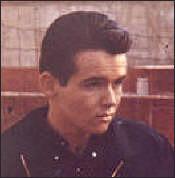 I was desultory about looking for a job
(read: "totally uninterested"), and Larry worked
only part-time, so we had long rambling conversations that went on for hours and
hours. We spent a lot of time talking about our lives growing up and about the
things we liked, and while we had sex with each other the overall relationship
was more fraternal than torrid. When I told Larry about my fascinated reading of
The Asiatics as a boy, he couldn’t wait to introduce me to Jim, an older
friend of his, who was a friend of Frederic Prokosch. (Jim was also a
senior VP in one of the hottest Madison Avenue ad agencies.) Then he rummaged around in
his suitcase, or perhaps he borrowed it from his friend, and came up with
an old copy of Nine Days to Mukalla, another Prokosch book with an exotic
locale and homoerotic tinges. And we took turns reading it aloud to each other.
I was desultory about looking for a job
(read: "totally uninterested"), and Larry worked
only part-time, so we had long rambling conversations that went on for hours and
hours. We spent a lot of time talking about our lives growing up and about the
things we liked, and while we had sex with each other the overall relationship
was more fraternal than torrid. When I told Larry about my fascinated reading of
The Asiatics as a boy, he couldn’t wait to introduce me to Jim, an older
friend of his, who was a friend of Frederic Prokosch. (Jim was also a
senior VP in one of the hottest Madison Avenue ad agencies.) Then he rummaged around in
his suitcase, or perhaps he borrowed it from his friend, and came up with
an old copy of Nine Days to Mukalla, another Prokosch book with an exotic
locale and homoerotic tinges. And we took turns reading it aloud to each other.
My own endeavors to read up and fill in the gaps in my college education had been typically academic in approach, and while I enjoyed my reading immensely there had been more rigor than spontaneity about it. Larry was very bright, but also a gadfly. He seemed to have followed up on anything and everything interesting that had ever crossed his line of sight. Between what came up in our day-in-day-out extended conversation, and his rummaging in that suitcase or a battered cardboard box of his stuff, our life at the Tiltin’ Hilton was something like a mental costume party or a fantasy excursion.
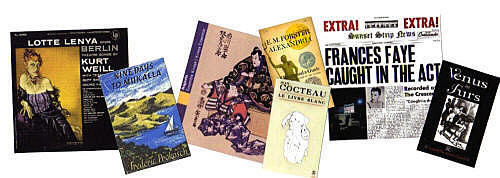
I remember E.M.Forester’s Alexandria, Von Sacher-Masoch’s Venus in Furs, La Bàs by Huysman and Cocteau’s White Book, as well as his novel The Imposter. Larry's treasure trove from California also included recordings of Weill’s German Theatre Songs by Lotte Lenya, an album of Kabuki theater music and like a dash of Tabasco sauce, Frances Faye's Caught in the Act recorded at the Crescendo…unfortunately until I got my hi-fi from my old apartment these latter goodies had to wait, and I had to be satisfied with the album copy and Larry’s enthusiastic descriptions.
This idyll ended after a month or so. First, the curtain shop that Larry worked in closed — it seemed that in 1961 New Yorkers were not interested in homespun looking monkscloth drapes available in seventy-one shades of beige. Then, Don got a chance to share an apartment with a friend of his and moved. Immediately Larry and I found ourselves trying to subsist on a Kaiser roll and orange juice at Bickfords in the morning and a two candy bars and a coke from the hotel vending machine in the evening. With our stomachs gnawing on our backbones, it was clear that even a seedy establishment like the Tiltin’ Hilton was too rich for our mutual blood.
PART II: What a Wonderful Town (including Links)
email to:
nycnotkansas@gmail.com